

Daycare Business Plan PDF Example
- February 28, 2024
- Business Plan

Creating a comprehensive business plan is crucial for launching and running a successful daycare. This plan serves as your roadmap, detailing your vision, operational strategies, and financial plan. It helps establish your daycare’s identity, navigate the competitive market, and secure funding for growth.
This article not only breaks down the critical components of a daycare business plan, but also provides an example of a business plan to help you craft your own.
Whether you’re an experienced entrepreneur or new to the service industry, this guide, complete with a business plan example, lays the groundwork for turning your daycare business concept into reality. Let’s dive in!
Our daycare business plan is thoughtfully developed to encompass all crucial aspects required for an in-depth strategic plan. It outlines our facility’s operations, marketing strategies, market dynamics, competitors, management team, and financial projections.
- Executive Summary : Offers an overview of your Daycare’s business concept, including the innovative learning environment, market analysis , management team, and financial strategy.
- Building & Location: Describes the Daycare’s modern, child-friendly design, its central location, and amenities such as indoor and outdoor play areas, sensory rooms, and nap zones.
- Pricing & Educators: Lists the services provided by your daycare, including full-time and part-time care options, the educator-to-child ratio, and pricing structure.
- Key Stats: Shares industry size , growth trends, and relevant statistics for the Daycare market.
- Key Trends: Highlights recent trends affecting the childcare sector, such as the increasing demand for early childhood education programs and technological integration.
- Key Competitors : Analyzes main competitors nearby and how your daycare differs from them, focusing on aspects like curriculum quality and additional services.
- SWOT: Strengths, weaknesses, opportunities, and threats analysis tailored to the daycare business.
- Marketing Plan : Strategies for attracting and retaining customers, including branding, local advertising, online presence, and community involvement.
- Timeline : Key milestones and objectives from the initial setup through the first year of operation and beyond.
- Management: Information on who manages the daycare, detailing their roles, experience in early childhood education, and business management.
- Financial Plan: Projects the daycare’s 5-year financial performance, including revenue projections, profit and loss statements, cash flow analysis, and balance sheet, aiming for significant growth and profitability by the target year.

Daycare Business Plan

Fully editable 30+ slides Powerpoint presentation business plan template.
Download an expert-built 30+ slides Powerpoint business plan template
Executive Summary
The Executive Summary serves as the gateway to your daycare business plan, providing a succinct overview of your daycare center and its offerings. It should highlight your market positioning, the variety of child care and educational services you provide, its location, size, and a sketch of daily operations.
This section should also delve into how your daycare will integrate into the local community, including an analysis of the number of direct competitors in the area, identifying who they are, along with your daycare’s distinctive features that set it apart from these competitors.
Moreover, you should incorporate details about the management and co-founding team, outlining their roles and contributions to the daycare’s success.
Additionally, a summary of your financial projections, including revenue and profits over the next five years, should be included here to offer a clear vision of your daycare’s financial strategy.
Make sure to cover here _ Business Overview _ Market Overview _ Management Team _ Financial Plan

Dive deeper into Executive Summary
Business Overview
For a Daycare, the Business Overview section can be effectively divided into 2 main components:
Building & Location
Briefly describe the daycare’s facility, focusing on its safety, child-friendly design, and the stimulating environment that it offers to children.
Mention the daycare’s location, emphasizing its accessibility and the convenience it brings to parents, such as proximity to residential areas or ease of drop-off and pick-up. Explain why this location is beneficial in drawing your target clientele, particularly parents who prioritize convenience and safety in their choice of daycare.
Pricing & Educators
Detail the range of childcare and educational services provided, from basic care for infants to preschool programs and after-school care for older children. Outline your pricing strategy , ensuring it aligns with the quality of care and education provided and is competitive within your market segment.
Highlight any special programs, discounts for siblings, or membership deals that offer additional value to families, fostering long-term relationships and loyalty among your clientele. Discuss the qualifications, experience, and approach of your educators and staff, underlining their role in creating a nurturing and educational environment for the children.
Make sure to cover here _ Building & Location _ Pricing & Educators

Market Overview
Industry size & growth.
In the Market Overview of your daycare business plan, start by examining the size of the childcare industry and its growth potential. This analysis is crucial for understanding the market’s scope and identifying opportunities for expansion, particularly in regions with increasing numbers of working parents or areas underserved by quality daycare facilities.
Key market trends
Proceed to discuss recent market trends , such as the growing demand for early childhood education, the importance of developmental programs, and the preference for daycares that offer flexible hours and holistic child development approaches.
For example, highlight the need for services that cater to different developmental stages and incorporate educational curriculums, alongside the rising popularity of daycares that focus on sustainability and health, such as offering organic meals or eco-friendly play areas.
Key competitors
Then, consider the competitive landscape, which includes a range of daycare options from high-end, education-focused centers to more affordable, home-based care, as well as the increasing availability of alternative childcare solutions like nanny-sharing.
For example, emphasize what makes your daycare distinctive, whether it’s through superior educational programs, exceptional staff qualifications, unique facilities, or flexibility in care options.
Make sure to cover here _ Industry size & growth _ Key competitors _ Key market trends

Dive deeper into Key competitors
First, conduct a SWOT analysis for the daycare , identifying Strengths (such as a qualified and caring staff, comprehensive educational programs), Weaknesses (like limited space or high operating costs ), Opportunities (for instance, a growing demand for quality early childhood education), and Threats (such as changes in government regulations or competition from new daycares).
Marketing Plan
Next, formulate a marketing strategy that details how to attract and retain families through targeted outreach, referral incentives, a strong online presence, and participation in community events.
Lastly, draft a precise timeline that marks crucial milestones for the daycare’s launch, marketing initiatives, enrollment targets, and growth plans, ensuring the business progresses with clear goals and intent.
Make sure to cover here _ SWOT _ Marketing Plan _ Timeline

Dive deeper into SWOT
Dive deeper into Marketing Plan
The Management section focuses on the daycare business’s management and their direct roles in daily operations and strategic direction. This part is crucial for understanding who is responsible for making key decisions and driving the daycare business toward its financial and operational goals.
For your daycare business plan, list the core team members, their specific responsibilities, and how their expertise supports the business.

Financial Plan
The Financial Plan section is a comprehensive analysis of your financial projections for revenue, expenses, and profitability. It lays out your daycare business’s approach to securing funding, managing cash flow, and achieving breakeven.
This section typically includes detailed forecasts for the first 5 years of operation, highlighting expected revenue, operating costs and capital expenditures.
For your daycare business plan, provide a snapshot of your financial statement (profit and loss, balance sheet, cash flow statement), as well as your key assumptions (e.g. number of customers and prices, expenses, etc.).
Make sure to cover here _ Profit and Loss _ Cash Flow Statement _ Balance Sheet _ Use of Funds

Related Posts

Carpet and Upholstery Cleaning Business Plan PDF Example
- June 17, 2024

Taxi Business Plan PDF Example

Self Storage Business Plan PDF Example
Privacy overview.
| Cookie | Duration | Description |
|---|---|---|
| BIGipServerwww_ou_edu_cms_servers | session | This cookie is associated with a computer network load balancer by the website host to ensure requests are routed to the correct endpoint and required sessions are managed. |
| cookielawinfo-checkbox-advertisement | 1 year | Set by the GDPR Cookie Consent plugin, this cookie is used to record the user consent for the cookies in the "Advertisement" category . |
| cookielawinfo-checkbox-analytics | 11 months | This cookie is set by GDPR Cookie Consent plugin. The cookie is used to store the user consent for the cookies in the category "Analytics". |
| cookielawinfo-checkbox-functional | 11 months | The cookie is set by GDPR cookie consent to record the user consent for the cookies in the category "Functional". |
| cookielawinfo-checkbox-necessary | 11 months | This cookie is set by GDPR Cookie Consent plugin. The cookies is used to store the user consent for the cookies in the category "Necessary". |
| cookielawinfo-checkbox-others | 11 months | This cookie is set by GDPR Cookie Consent plugin. The cookie is used to store the user consent for the cookies in the category "Other. |
| cookielawinfo-checkbox-performance | 11 months | This cookie is set by GDPR Cookie Consent plugin. The cookie is used to store the user consent for the cookies in the category "Performance". |
| CookieLawInfoConsent | 1 year | Records the default button state of the corresponding category & the status of CCPA. It works only in coordination with the primary cookie. |
| elementor | never | This cookie is used by the website's WordPress theme. It allows the website owner to implement or change the website's content in real-time. |
| viewed_cookie_policy | 11 months | The cookie is set by the GDPR Cookie Consent plugin and is used to store whether or not user has consented to the use of cookies. It does not store any personal data. |
| Cookie | Duration | Description |
|---|---|---|
| __cf_bm | 30 minutes | This cookie, set by Cloudflare, is used to support Cloudflare Bot Management. |
| language | session | This cookie is used to store the language preference of the user. |
| Cookie | Duration | Description |
|---|---|---|
| _ga | 2 years | The _ga cookie, installed by Google Analytics, calculates visitor, session and campaign data and also keeps track of site usage for the site's analytics report. The cookie stores information anonymously and assigns a randomly generated number to recognize unique visitors. |
| _ga_QP2X5FY328 | 2 years | This cookie is installed by Google Analytics. |
| _gat_UA-189374473-1 | 1 minute | A variation of the _gat cookie set by Google Analytics and Google Tag Manager to allow website owners to track visitor behaviour and measure site performance. The pattern element in the name contains the unique identity number of the account or website it relates to. |
| _gid | 1 day | Installed by Google Analytics, _gid cookie stores information on how visitors use a website, while also creating an analytics report of the website's performance. Some of the data that are collected include the number of visitors, their source, and the pages they visit anonymously. |
| browser_id | 5 years | This cookie is used for identifying the visitor browser on re-visit to the website. |
| WMF-Last-Access | 1 month 18 hours 11 minutes | This cookie is used to calculate unique devices accessing the website. |
- Skip to primary navigation
- Skip to main content
- Skip to primary sidebar
- Skip to footer
Legal Templates
Home Business Business Plan Daycare
Daycare Business Plan Template
Download our template and create a business plan for your daycare!
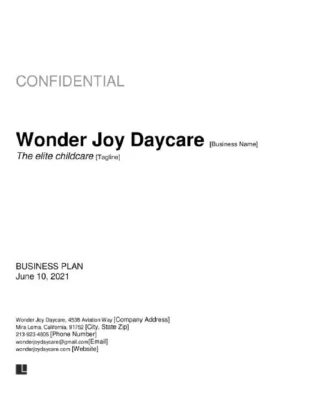
Updated September 22, 2023 Reviewed by Brooke Davis
When you are ready to start a daycare business, you need an effective plan outlining how to get there. High-quality child care is in high demand, but you must be prepared for the challenges of starting a new business.
A solid business plan will get you off on the right foot before you even open the doors of your new facility.
With these helpful tips, you can learn how to make a business plan for a daycare center. Whether you are looking to watch over young children or even need a dog daycare business plan, Legal Templates is here to help you get started.
Why You Need a Business Plan for Your Daycare Business
How to write a business plan for a daycare.
- Management Team
Daycare Business Plan Sample
A business plan sets the stage for how you will operate your business and how you will get it running. A daycare is no different. Opening a daycare requires intensive planning, legal compliance, and understanding of your market.
A daycare business plan template walks you through the steps to build a proper path forward. Every successful business is planned correctly, not as you go along.
A sample daycare business plan pdf or Word document lays it out for you. You can learn how to put it together and what you must include. Many business plans help you understand what you must do to prepare.
Some are designed to recruit potential investors to your cause. Either way, you need a business plan to prepare you for the challenges and successes ahead.

Knowing how to write your daycare business plan can be tricky without some help. You may not have done this before, but a daycare business plan example can help.
Follow these writing tips in each section to create a strong business plan for your future daycare.
1. Executive Summary
The initial section of your business plan is the executive summary. This part of your plan is an introduction for whoever reads it. It is designed to offer an overview of the remaining sections. It should be concise and add only summary details—this is not the section for intensive information or data.
The executive summary will highlight what your daycare business will look like and the most crucial section of your entire plan.
This section may provide information such as:
- A business address
- Phone number, email address, and other contact information
- List of owners
- Banking information
- Start date for the daycare
- Client base
- Market niche
- Factors for success
The executive summary lets you make a case for why your particular daycare will be successful and competitive. It is also the section that helps you sell yourself and your business to potential investors who may play a critical role in starting your daycare.
Provide a mission statement that reflects your goals for the daycare and your motivation for starting your business.
2. Management Team
Your daycare business plan should include important information about your management team. The first part of this section may address ownership of the business itself. It should outline all essential ownership details, such as:
- Legal names of every owner
- Each owner’s proportionate share
- The format of ownership percentage (i.e., stocks, capital investments, etc.)
- The format of the business (Corporation, LLC, etc.)
- Contact information for each owner
You want everyone who reads this business plan to know who has a stake and how their interests are represented. These details are a crucial part of business formation and preventing costly legal disputes in the future.
The management team section should also include the profiles of your management staff. These people will run the business daily, and they should be properly vetted before being put in charge.
Your business plan should list the management teams’:
- Names and positions
- Summary of responsibilities
- Credentials and education background
- Prior employment or experience
- Early childhood education licensing or other credentialing
- Management experience
- Salary and benefits
- Past success in a similar role
This information should demonstrate why these are the right people for the job. Not only does it help you know how your business will run, but it also shows others you have a proper plan in place for your daycare.
3. Products and Services
This section lets you talk about why you are starting this business in the first place. You will outline the services or products you intend to sell to consumers. For a daycare, it should outline the following:
- Who is being cared for: Children, elderly adults, or pets?
- Business hours
- Staff costs and required credentials
- Will you offer food, diapers, and other child-care products?
- How will you measure sales metrics
Daycare is typically considered a service, but product sales are also often a part of this model. Your plan should adequately account for how you will handle this dual purpose and how it fits into your business model.
4. Customers and Marketing
You must identify your market and how you will get customers into your daycare. This section will focus on your area’s need for daycare services and the types of customers you expect to get.
Identification of customers is a vital part of a business plan and should include details like:
- How many parents need childcare services?
- What costs can families be expected to pay for your services
- The community you will target
- Demographic data for potential customers
With your customers in mind, you can focus on your marketing strategies. You want to differentiate yourself from competitors and ensure the community knows your new business. The daycare business plan must outline how you will achieve these goals.
A marketing strategy should combine both traditional and digital marketing methods, including:
- Open houses
- Word-of-mouth advertising
- Advertisements in the paper or yellow pages
- Billboards or other ads
- Television, radio, or internet advertisements
- Social media pages
5. SWOT Analysis
A SWOT analysis will address your daycare’s strengths, weaknesses, opportunities, and potential threats. This analytical method examines your company and how it will operate.
It puts each of the four metrics into a visual matrix to help prospective business owners quickly identify favorable and unfavorable factors that may affect their business venture.
A SWOT analysis should focus on how your daycare services can perform against competitors. It may address factors like:
- Any threats the daycare may face
- Competitive advantages and why they would be successful
- Areas that may be improved over time
- Technology or resources the company may use to increase efficiency
- Internal factors that may affect economic success
Detailed SWOT sections show investors you have done your homework and give you valuable data to make informed business choices.
6. Financials
A business plan should address the unique financial situation you face. Your daycare business plan should demonstrate your break-even amounts and expected profit margins.
It will also address the costs and the areas of revenue you expect. You will want to address the following:
- Enrollment fees
- Payment plans
- Cost of supplies and materials
- Employee costs
- Regulatory costs
- Additional program offerings and revenue
- Necessary loans or capital improvements
A well-developed budget can demonstrate expected cash flows versus expected expenditures. Knowing how to handle these costs will be incredibly helpful in starting your daycare.
7. Operations
Your operational plan should outline specific procedures your business and staff will follow. It will list employees and those in management positions and their responsibilities.
As in your management section, a detailed “chain of command” is essential. Staff are an important part of your operations and should be detailed here.
One of the most important aspects of a daycare operation is its location. It would be best if you addressed the following:
- The facility’s address
- The type of area it is in (residential, commercial)
- The space available and amenities
- Why is it a prime location
- Accessibility to the community for drop-off
You should also list your business hours and the services you will have available at different times. Child daycare centers differ in when they offer care—whether during the day, evenings, or even on weekends.
If you are doing other forms of daycare, you may even utilize late or overnight hours. You can decide how you run your business, but operations should be clearly outlined in your business plan.
8. Appendix
The appendix section allows you to include other documents that add to your business plan. They may include legal documents like licensing credentials, insurance information, and business formation documents.
Additional documents in this area are meant to support your business plan. The appendix might also include the following:
- Reference letters
- Photographs of the facility, locations, or general area
- Market research data
- Compliance Requirements
The appendix is a flexible section that lets you add supporting documents and other relevant information. Only add details that are helpful to your business plan. The appendix does not need to be lengthy or filled with fluff.
Legal Templates has the daycare business plan sample you need to construct your plan. With this sample at your disposal, you can formulate a business plan for your daycare to show to investors or for your purposes.
You may also use a business plan builder template to help you construct your daycare business plan step by step. See the sample below to help you get started.
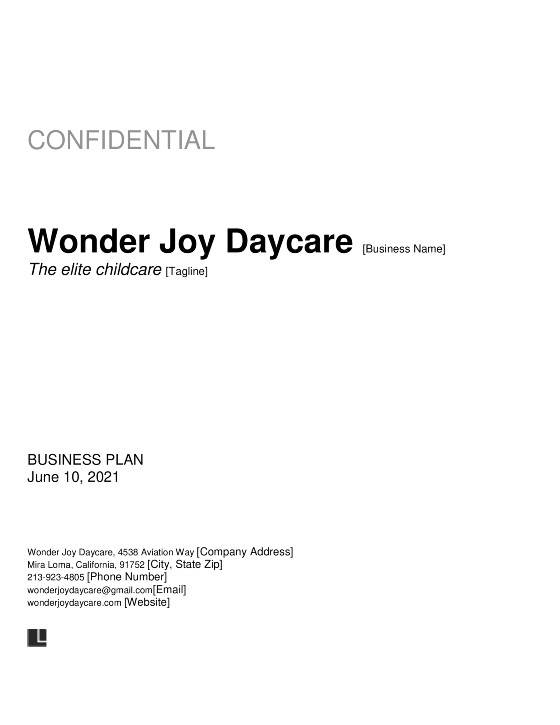
- Legal Resources
- Partner With Us
- Terms of Use
- Privacy Policy
- Do Not Sell My Personal Information
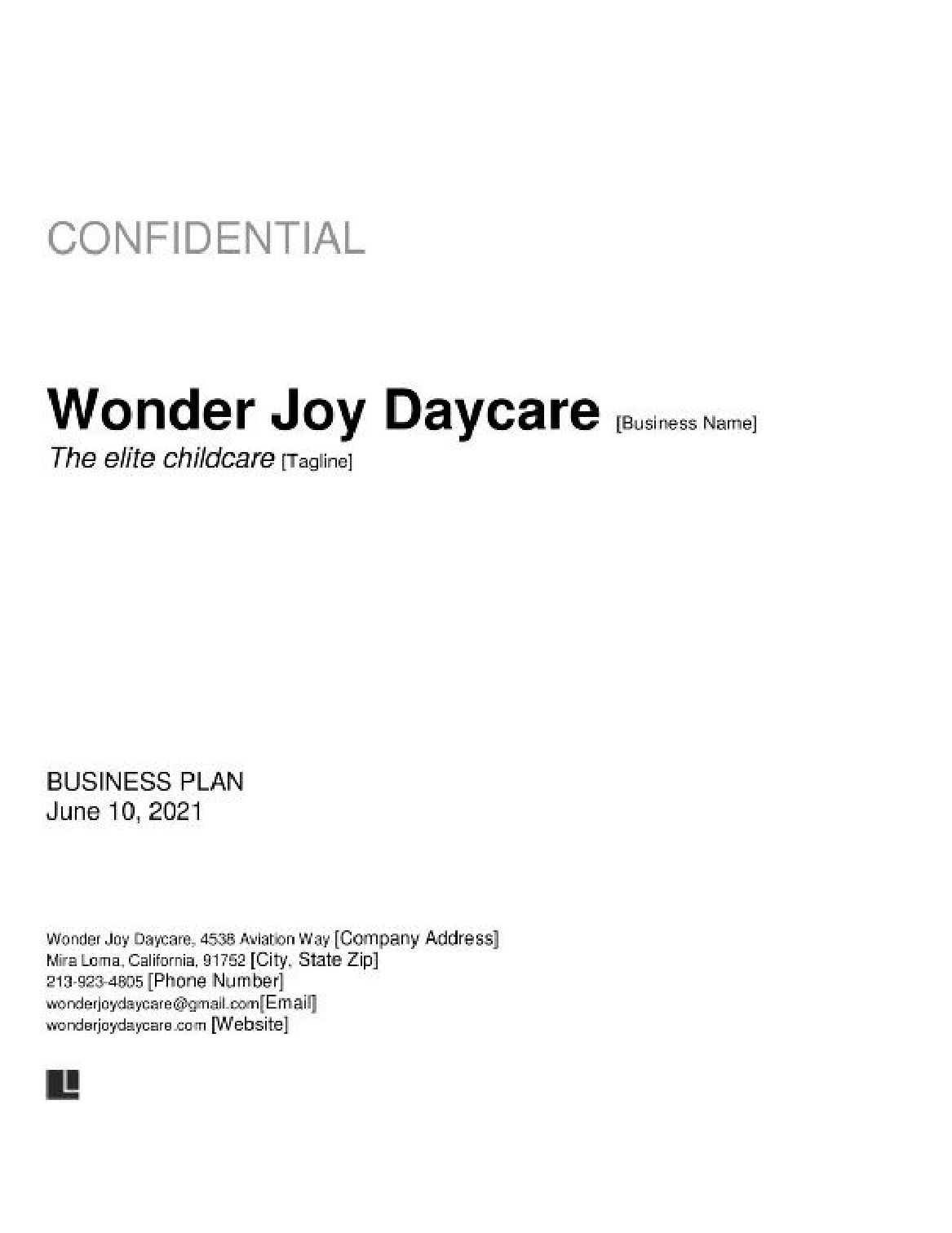
The document above is a sample. Please note that the language you see here may change depending on your answers to the document questionnaire.
Thank you for downloading!
How would you rate your free template?
Click on a star to rate
The Daycare Business Plan Blueprint (Examples + Template)

April 14, 2022
Adam Hoeksema
Starting a daycare business can be a daunting task. There are so many things to think about and plan for. You need to find the perfect location, get the right licenses and permits, hire qualified staff, and, most importantly, create a daycare business plan.
Creating a daycare business plan is one of the most important steps in starting your business. A well-thought-out business plan will help you get funding, attract investors, and operate your business effectively.
The bad news is that there is a lot of advice out there on writing a business plan. With so much information and tons of daycare business plan examples to choose from, it can be overwhelming to know where to start.
The good news is, we've got you covered. In this article, we'll give you a comprehensive guide on how to write a daycare business plan. We will also provide some examples and a free daycare business plan template to get you started.
But First...Is a Daycare a Good Business to Start?
Before we talk about how to create a daycare business plan, let's first answer the question: is starting a daycare a good business to get into?
The answer is a resounding yes! The daycare industry is growing rapidly. It is one of the few businesses that are not only recession-proof but also thrives in uncertain economic times.
According to the National Association of Child Care Resource & Referral Agencies (NACCRRA), the demand for child care services has increased by 26% over the last decade. This demand is only expected to grow in the coming years.
When it comes to profitability, the daycare industry is very attractive. According to IBISWorld , the average profit margin for a daycare business is around 15%. That's higher than the average for most other industries!
If you're thinking about starting a daycare business, know that you are getting into a very profitable and in-demand industry. Now let's talk about how to write a daycare business plan that will help you start and grow your business successfully.
How to Create a Daycare Business Plan
A daycare business plan is as simple as a word document with the following sections:
- Business Description
- Market Analysis
Business Model
- Location and Facility
- Marketing Plan
- Financial Plan
Executive Summary
This article will provide context of what to include in each section of your daycare business plan. As you work on writing your business plan, you will want to grab our daycare financial projection template as well in order to complete the financial plan section.
Your daycare business plan should be an elevator pitch in itself. It should be attractive to potential partners and investors. Basically, it should give them a clear idea of your business, where it is located, what services you offer, who your target market is, and how you plan to make money.
Creating a daycare business plan doesn't have to be complicated. In fact, the cheapest and easiest approach is to simply start with a blank word document and work through each of the above sections, it can be pretty easy. Here is a step-by-step guide on how to create a daycare business plan:
Create a Compelling Business Description
Your daycare business's unique selling point (USP) should be the first thing you include in your business plan. What is it that makes your daycare center different from all the others?
This description should be the foundation of your marketing efforts as well.
There are a few questions you should answer in your company description. They include:
What's your Curriculum Based On?
Potential investors, partners, and even customers will be interested in knowing what your curriculum is based on. This will help them understand the environment children will be in a while under your care.
When describing your curriculum, make sure to include:
- What age ranges do you cater for?
- The type of care you offer (full-time, part-time, drop-in)
- Your educational philosophy
- The activities and programs you offer
For example, if your daycare is unique by offering a Montessori curriculum, you will want to highlight that. In fact, you can learn more about how to start a Montessori program here .
How Big is Your Facility?
The size of your facility will say a lot about the type of operation you're running. Are you a small, home-based daycare or a large center with multiple classrooms?
This section of your business plan may include:
- A floor plan of your facility
- The capacity of your facility
- The number of employees you have
- Type of equipment and furniture you have
Who Is Your Target Market?
You can't market to everyone, so you must identify your target market. This will help you focus your marketing efforts and ensure that you're reaching the right people.
Below is a daycare business plan example that shows how your business description should be:
“ABC Daycare is a small, home-based daycare located in San Francisco, CA. We cater to children aged 0-12 years old and offer full-time, part-time, and drop-in care.
Our curriculum is based on the Reggio Emilia approach, emphasizing hands-on learning and collaboration. Activities and programs include arts and crafts, music, and outdoor play.
Our facility can accommodate up to 12 children at a time. We have a staff of four employees who are all CPR and First Aid certified.
Our target market is working parents in the city who need quality child care but can't afford the rates of larger daycare centers. We've created an affordable subscription-based pricing model for our target market to fulfill the demand. We generate revenue through monthly subscriptions and have low operating costs due to our small size.
Our suppliers are local businesses that provide us with food, toys, and other supplies.”
Do a Thorough Market Analysis
After writing a compelling description of your business, you need to do a thorough marketing analysis. This analysis will help you determine your target market, what type of advertising and promotion will work best, and how to price your services.
You should also research the competition and see what they are doing right and wrong. This information will be invaluable as you create your daycare business plan.
Keep these things in mind when doing a market analysis:
The Size of Your Market
This is determined by the number of potential customers in your area who need or want your services.
For example, if you live in a small town with only a few thousand people, there may not be enough demand to support a large daycare facility.
On the other hand, if you live in a city with hundreds of thousands of people, there may be room for multiple daycare facilities.
Your target market is the segment of the population that is most likely to use your services. This includes factors like age, income, education, and location.
After you've identified your target market, you need to show how you plan on fulfilling the demand. This is where your business model comes in.
Your business model is a detailed description of how your daycare will operate daily. It should include:
- How do you plan on acquiring customers?
- What are your pricing strategies?
- How will you generate revenue?
- What are your operating costs?
- Who are your suppliers?
Your business model should be detailed and easy to understand. It should also be realistic and achievable.
Here is a daycare business plan example of a business model for a small daycare center:
“The daycare will be open Monday through Friday from six in the morning to six at night. We will offer care for children ages six weeks to twelve years old.
Our rates will be $50 per week for one child and $40 per week for each additional child from the same family. We will offer a discount of $20 per week for families who enroll their children for an entire year.
We will generate revenue by charging weekly rates for our services. Our operating costs will include rent, utilities, supplies, and salaries for our employees. Also, we will acquire customers through online advertising and word-of-mouth.”
As you can see, a business model is a detailed description of how your business will operate. It's essential to have one in place before promoting and selling your services.
One thing you should not forget to include in your daycare business plan is the location of your business and your rental agreement. If you are renting a space, including the terms of your agreement and how long you have the space. If you are purchasing a property, include information on the property, such as square footage and any special features that will help your business stand out.
This daycare business plan example shows you how to include this vital information:
“The daycare will be located at 123 Main Street in a commercial space currently leased by the owner. The lease agreement is for three years with an option to renew for an additional three years. The monthly rent is $2000, and the security deposit is $3000.
The daycare will have exclusive use of the main floor, including a large open play area, a small kitchen, two bathrooms, and four classrooms. The daycare will also have access to the outdoor playground.
80% of our space will be used for childcare, with the other 20% used for our administrative offices and staff lounge.
We have chosen this location because it is close to several residential neighborhoods and has easy access to public transportation. The space is also large enough to accommodate our future growth.”
There are many daycare business plan templates you can use to help you get started. This is a basic outline of what should be included.
Daycare Marketing Plan
Most daycare business plan templates will include a section for your marketing plan. Most people overlook the marketing aspect of their business, but it is one of the most important pieces of your puzzle.
In your business plan, you need to outline your target market, your marketing strategies, and how you plan on executing those strategies.
You also need to set aside a budget for your marketing efforts. Many people make the mistake of thinking that they don't need to spend money on marketing, but that couldn't be further from the truth.
The following daycare business plan example shows you how you should describe your marketing efforts:
"Our target market is working for families with children between six weeks and five years old. We will reach our target market through online and offline marketing efforts.
Some of the offline marketing strategies we will use include print advertising, flyers, and word-of-mouth referrals. We will use a mix of SEO, content marketing, and social media for online marketing.
We have set aside a budget of $500 per month for our marketing efforts."
As you can see from the example above, your marketing plan should be clear, concise, and to the point. Don't forget to include a budget!
Daycare Financial Plan
Your business plan should include a financial plan section. This is where you'll lay out how much money you need to start or grow your business. Be specific and include dollar amounts. If you're seeking a loan, including information on how much you're requesting and how you'll use the funds.
You should also include a detailed budget in your business plan. Your budget should include all of your projected income and expenses for at least the first year of operation. Creating a budget will help you get a clear picture of what it will cost to start and operate your business.
This section should include projected costs for:
- Rent or mortgage payments
- Advertising and marketing
- Operating expenses such as utilities, supplies, and more.
Startup costs are another vital item to include in your business plan. This is the money you need to purchase equipment, furniture, or any other items to get your business up and running.
If you plan to secure a loan, your lender will want to see a detailed business plan with information on how you plan to use the loan funds. Ensure you include this information in your business plan to increase your chances of securing funding.
If you're seeking funding from investors, you'll need to include information on how they will be compensated. This is typically done through equity, a percentage ownership stake in your business.
For example, if you seek $100,000 in funding and offer a 20% equity stake, the investor will own 20% of your business.
Make sure you use a daycare business plan template that includes a section on funding to ensure you include all the necessary information. If you’re planning to get a loan or seek investment, you’re going to need full financial projections. Our daycare financial model will provide up to 5 years of projected income statements, cash flow and balance sheet forecasts.
Next I want to answer some key financial questions for you as you consider how to forecast your daycare financials. I am going to hit on:
- Daycare Startup Costs
- Daycare Revenue
- Daycare Facility Operating Expenses
- Daycare Profitability
Let’s dive into some key questions.
How much does it cost to start a daycare?
It costs between $10,000 and $50,000 to start an in-home daycare business according to Bizfluent .
It costs between $59,000 and $3 million dollars to start a daycare facility according to Bizfluent .
So obviously this is a huge range in startup costs. The main thing that will determine your startup costs is your daycare facility. Depending on how large your daycare is, whether you are buying, building, or leasing the space, and how much renovation needs to be done, your startup costs can vary drastically.
Some tips to help you estimate a cost of a daycare facility:
- A daycare facility should have 35 square feet of open floor space indoors per child.
- So if you wanted a facility that could care for 100 children you would need 3,500 square feet of indoor space for children, plus additional space for offices, kitchen, bathrooms, etc. Let’s assume that you would need at least 5,000 square feet of space for a daycare facility that served 100 children.
- A daycare center would cost at least $295 per square foot to construct in the U.S. based on data from Levelset .
- Constructing a new 5,000 square foot daycare center would likely cost at least $1,475,000 based on $295 per square foot.
- Now you might not be constructing new, rather you might rent an existing facility which could require renovations. You will need to get a specific quote for the specific renovations that you need for your space.
How much revenue can a daycare business make?
A daycare facility can generate $17,680 in revenue per year per child according to Zippia .
A daycare business with 100 children can generate over $1.75 million per year in annual revenue based on our average revenue per child of $17,680.
How much does daycare cost?
The average cost of daycare is $17,680 per year, per child in the U.S. according to Zippia .
This means that the average monthly cost of daycare in the U.S. is roughly $1,475.
What is the typical child to staff ratio for a daycare?
The typical child to staff ratios for a daycare are:
- 1 adult staff for every 4 infants (age 0 to 12 months)
- 1 adult staff for every 6 toddlers (age 1 to 3 years)
- 1 adult staff for every 10 pre schoolers (age 3 to 5 years)
- 1 adult staff for every 12 school aged children (5+ years old)
Source - Childcare.gov
These ratios will help you estimate how many staff members you will need. Our financial projection template makes this easy. Just enter in your ratios and the number of children you expect to have in each age group and the model will automatically calculate the number of staff required to maintain your ratios. See the input daycare staffing table below:

What are the typical operating costs for a daycare?
Your largest operating expense for a daycare facility is likely to be your rent.
It should cost between $20 and $30 per square foot to rent a daycare center space based on available spaces on Loopnet .
Other operating costs for a daycare center include:
You can see how you can enter in your operating costs into our financial model below:

How much profit can a daycare make?
The average daycare profit margin is 6.5% according to Daycare Business Boss .
Once you complete your projections you will want to take a look at our At a Glance tab to make sure that your projected profit margins aren’t way out of line with the industry norms. You can find projected profit margins for your daycare below:

This is an important aspect that you may not find in most daycare business plan templates, but it's still essential. An appendix includes any additional information to help you understand your business plan. This might include things like your:
- Business licenses
- Insurance policy
- Lease agreement
- Sample contracts
- Staff bios
This section adds credibility to your daycare business plan and shows that you've done your homework. Including all of the necessary details in your appendix will give investors peace of mind and show that you're serious about starting a daycare center.
An executive summary is a brief overview of your business plan and is often considered the most important section. It should be two pages long, with a clear description of your business, your goals, and why you will achieve them.
There are several key elements to include in your executive summary:
- Business Name: This is the name you have chosen for your business.
- Location: Include the city, state, and country where your business will be located.
- Business description: Describe what type of business you will be operating.
- Target market : This is the group of people you will be targeting as customers.
- Competition: Who are your competitors, and how will you compete with them?
- Product or service : What product or service will you be offering?
- Sales and marketing: How will you generate sales?
- Financials: Include a five-year income statement, balance sheet, and cash flow statement.
- Management team: Introduce your management team and their experience.
- Exit strategy : This is the plan for how you will eventually sell or otherwise exit the business in case you decide to retire or move on to other projects.
The executive summary is the most crucial section of your business plan because it gives investors and lenders a quick overview of your company and its prospects. Be sure to include all of the key elements listed above, and keep it under two pages in length.
What Are The Benefits of Creating a Daycare Business Plan?
Research shows that a business plan helps business owners make better decisions, turn abstract goals into tangible objectives, and track progress over time. But what does this mean for those who want to open a daycare?
Creating a business plan forces you to think through every step of starting your company. It's a valuable exercise that can save you time and money in the long run. Even if you don't end up following your business plan to a tee, the process of writing it will help you better understand your business and what needs to be done to make it successful.
There are many benefits to creating a daycare business plan, including:
Gives You a Roadmap to Follow
As with any journey, it's always helpful to have a map. A business plan is that map for your daycare business. It will give you a clear idea of where you want to go and how you can get there.
Helps You Secure Funding
A business plan is essential if you're looking for investors or loans. It will show potential lenders and investors that you've put thought into your business and have a solid strategy for making it successful.
Ensures Your Daycare Business is Feasible
When you're starting a business, it's easy to get caught up in the excitement and overlook potential problems. A business plan forces you to take a step back and assess whether your business is truly viable. It also helps you identify any areas where additional research is needed.
Final Thoughts
A daycare business plan is a valuable tool to help you make your business successful.
It is worth noting that your business plan is not a one-time exercise but should be updated regularly as your business grows and changes. This document is meant to be a living document that evolves as your business does.
If you're unsure where to start, there are plenty of resources available to help you, including daycare business plan examples online, books, and daycare business plan templates.
You can also use our daycare projection template to get your financial plan ironed out and ready for your business plan.
The most important thing is just to get started. The sooner you create your business plan, the better prepared you will be for success.
You can get the Daycare Facility financial projection template here!
The template is simple to use and will save you loads of time while still producing professional looking daycare projections. ProjectionHub has helped more than 50,000 businesses create financial projections so you can be confident that you can do it too.
The daycare business projection template includes:
5 Year Daycare Facility Pro Forma Financial Statements
CPA Developed & Completely Customizable
Free Support & Projections Review
Compatible with Google Sheets
Free expert review of your completed projections
The template is easy to use and you do not need to be an excel wizard to fill it out. Editable cells are highlighted in blue, a video guide is included, and our team is available to answer any questions you have.
You can see the complete walkthrough and demonstration of the daycare business forecast template here:
Get the template today for just $79

If you have any questions before purchasing, please feel free to begin a live chat or email us at [email protected]
100% money back guarantee in accordance with our terms and conditions
Photo by Pixabay
About the Author
Adam is the Co-founder of ProjectionHub which helps entrepreneurs create financial projections for potential investors, lenders and internal business planning. Since 2012, over 40,000 entrepreneurs from around the world have used ProjectionHub to help create financial projections.
Other Stories to Check out
Common troubleshooting questions about projectionhub templates.
Check out the quick and easy ways to address some of the most common troubleshooting questions we hear about the excel templates at ProjectionHub!
5 Key Tips to Make Your Startup Business Plan Shine for an SBA Loan
Learn 5 key tips to make your startup business plan stand out and secure an SBA loan, from demonstrating market potential to creating realistic financial projections.
How to Know if Your Financial Projections are Realistic
It is important for financial projections for a small business or startup to be realistic or else an investor or lender may not take them seriously. More importantly, the founder may make a financial mistake without a reliable plan.
Have some questions? Let us know and we'll be in touch.

Free Download
Child Care Business Plan Template
Download this free child care business plan template, with pre-filled examples, to create your own plan..
Or plan with professional support in LivePlan. Save 50% today
Available formats:
What you get with this template
A complete business plan.
Text and financials are already filled out and ready for you to update.
- SBA-lender approved format
Your plan is formatted the way lenders and investors expect.
Edit to your needs
Download as a Word document and edit your business plan right away.
- Detailed instructions
Features clear and simple instructions from expert business plan writers.
All 100% free. We're here to help you succeed in business, no strings attached.
Get the most out of your business plan example
Follow these tips to quickly develop a working business plan from this sample.
1. Don't worry about finding an exact match
We have over 550 sample business plan templates . So, make sure the plan is a close match, but don't get hung up on the details.
Your business is unique and will differ from any example or template you come across. So, use this example as a starting point and customize it to your needs.
2. Remember it's just an example
Our sample business plans are examples of what one business owner did. That doesn't make them perfect or require you to cram your business idea to fit the plan structure.
Use the information, financials, and formatting for inspiration. It will speed up and guide the plan writing process.
3. Know why you're writing a business plan
To create a plan that fits your needs , you need to know what you intend to do with it.
Are you planning to use your plan to apply for a loan or pitch to investors? Then it's worth following the format from your chosen sample plan to ensure you cover all necessary information.
But, if you don't plan to share your plan with anyone outside of your business—you likely don't need everything.
More business planning resources

Business Plan Template

How to Write a Business Plan

Simple Business Plan Outline

How to Start a Business With No Money

Industry Business Planning Guides

How to Create a Business Plan Presentation

How to Write a Business Plan for Investors

10 Qualities of a Good Business Plan
Download your template now
Need to validate your idea, secure funding, or grow your business this template is for you..
- Fill-in-the-blank simplicity
- Expert tips & tricks
We care about your privacy. See our privacy policy .
Not ready to download right now? We'll email you the link so you can download it whenever you're ready.
Download as Docx
Download as PDF

Finish your business plan with confidence
Step-by-step guidance and world-class support from the #1 business planning software

The quickest way to turn a business idea into a business plan
Fill-in-the-blanks and automatic financials make it easy.
No thanks, I prefer writing 40-page documents.

Discover the world’s #1 plan building software

Daycare Business Plan Creation – Includes Template Download
Video - daycare business plan, daycare business plan: executive summary, opening a daycare: location, location, location, employees and responsibilities, market niche, financial info, operational plan, marketing plan, revenue opportunities, purpose of loan, business feasibility, financial projections.
- Download >> Daycare Business Plan [FREE Template]

What if Starting a Daycare was Easier Than You Ever Imagined?
It all starts with creating a good daycare business plan. With the right plan in place, opening a daycare has never been easier!
Our comprehensive guide will walk you through creating a business plan . At the end, be sure to download our free template and hit the ground running!

The actual daycare business plan may look pretty long once you have everything filled out. To make things easier for everyone from the bank to your employees though, you should begin with an executive summary.
An executive summary provides key info, including business address, phone number, and who to contact. It will also outline the business structure, the list of owners, banking info, and the anticipated start date for your daycare.
The summary should also include a snapshot of your business concept, a description of daily business, and a rundown of your employees. Finally, it should include who your client base is, what your market niche is, and what factors make your success very likely.
Our guide will take you on a deeper dive into some of these different parts of the summary, and you can always work with an outside child care consultant to get things "just right." But it's important that your executive summary provide all of this key info at a glance.

One of the biggest decisions to make is where you will open a daycare. You must decide whether to run the daycare out of your home or run a group child care center . Child Care Biz Help works mainly with existing and start-up group child care centers.
Provided that you have enough room, using your home for the daycare business helps to cut down on costs, but keep in mind home daycares limit the number of children that you can care for, which ultimately restricts the amount of revenue you can earn.
When choosing a group child care center, you have several options:
- New building
- Existing center
Whichever options you choose, make sure you know how much everything will cost. This is vital info for your business plan, especially when you get financing.

The business plan should include as much info about your employees as you have. It's true that you may not know everything about everyone you plan to hire, but any info that you already have should go in the plan.
For example, the plan should include the overall number of employees you plan to have. Furthermore, it should outline the exact responsibilities that each person has so that it's clear who the owners are, who the director and teachers are, and who the other support staff is.
Regarding your management team, the business plan should include their relevant background and experiences. And you can use this section to outline some of the ways that you might screen applicants (such as criminal background checks, letters of reference, and personal interviews).
Again, you may make personnel changes over time. But the stronger your first set of employees is, the easier it will be to get this business off the ground!

Let's face it: there are plenty of daycares out there. And all of the daycares in your area are now your competition. That's why your business plan should include info about your specific market niche.
Will you specialize in attending to the needs of a particular set of children? Or will your teachers embrace a specific teaching style such as the Montessori Method ?
There is plenty of room to get creative here. After all, chances are you want to open a daycare because you can do it better than other people. This is simply the section to explain why your business will be the best!

Finances play multiple roles in your plan. But the first area occurs right after your executive summary. This is where you lay out all of the relevant financial details in one place.
The info should include how much your daycare equipment will cost, how much your furnishings will cost, and how much transportation will cost. You will also need to provide info about how much operating capital you currently have and how much your intended renovations are going to cost.
Make sure this section is accurate so that you can get all of the money that your business will need!

The daycare business plan should include an operational plan section. This is where you go on to outline specific individuals as well as their titles, responsibilities, qualifications, and payscale. Keep in mind the center director position is one of the most important positions to hire for.
This is also a good section to outline the value of your project. Here, you provide an itemized list of different things (like the plumbing, drywall, and electrical) and how much they cost. Do the same thing with any machinery, equipment and furniture. Don't forget to include any playground costs which can be very significant when you're a new start-up.
Finally, this section should include a description of your business operations. Be sure to include the "little things" (like creating daily schedules and installing equipment) as well as the "big things" (teaching children of a certain age range, following health and safety guidelines, etc.).

It's one thing to have a great business and it's another thing for people to know you have a great business. That's why every good business plan should include a marketing plan.
In this section, you should be specific about who your primary target audience is and what communities they live in. Provide very specific demographic data before you pivot into the marketing strategy.
That strategy should include any combination of traditional and digital marketing methods. This might range from newspaper and radio advertisements to social media and SEO campaigns.
Over time, you will discover which marketing methods are better than others. But this section should include every marketing method that you plan to try.

Most people plan to start a daycare because they want to give back to the community in some way. With that in mind, the purpose of any business is to generate profit. And your business plan must include info about the different revenue opportunities of your business.
The most basic form of revenue will come from the weekly or monthly enrollment fees for taking care of children. You can simply calculate the anticipated number of children (and their age ranges) with your rate in order to calculate an approximate monthly revenue.
In addition to that, you might consider adding enrichment programs and registration fees as revenue opportunities. It's all a matter of finding a balance between a quality program and a program parents can easily afford.

The business plan should include a section for the purpose of your loan. In this section, you will identify, down to the dollar, what your intended loan needs to cover.
This should be an itemized section so that the lender knows how much is going towards renovations, furniture, equipment. And you should use this section to reiterate what your current operating capital is.
When the smoke clears, we should have a clear idea of the project cost, your equity and contributions, and what the total financing required will be. Without this info in place, it's impossible to get your business off the ground.

What is a lender's primary consideration when a business needs money? Simple: they want to know the business will succeed. That's why your business feasibility section is so important.
At the bare minimum, this section should include research data about which factors will make your daycare in this area successful. If you have any feasibility studies or other intensive research you can cite, this is the section for it.
Ideally, this section should also include a full-blown SWOT analysis . This shows lenders and investors that you have a keen understanding of what your business does well and what it might need to work on.
Finally, this section should include your long-term plans. Outlining how you plan to grow and adapt your business helps reassure lenders and investors that you are prepared for the future.

The final section is straightforward and to the point. This is where you attach the financial projections you have completed for your business.
We recommend including cash flow projections for the first twelve months and cash flow projections for the first three years. On top of that, you should include three years of projected income statements and balance sheets.
Obviously, much can change in the space of three years. But healthy financial projections for the next few years are a great way to win skeptical audiences over.
Download >> Daycare Business Plan [FREE Template]

Now you know how to create a daycare business plan . But do you know who can make it nice and easy?
All you need to do is complete the form below to download your free plan template. And for more tips about opening a daycare or if you're interested in hiring us to help, contact us today!
Q: What should be considered when developing budgets for a daycare or preschool?
A: When developing budgets for a daycare or preschool, it is important to consider several factors to ensure the smooth running of your business. One essential aspect is analyzing your current cash flow and expenditures, which allows you to determine whether your operations will result in a profit. Additionally, it is crucial to build a budget that takes into account unexpected costs that may arise, such as repairs or equipment replacements.
Apart from regular expenses, it is important to consider specific factors related to the nature of your business, such as the number of children you need to serve in order to cover your bills and maintain financial stability. This analysis will help you understand the enrollment capacity required to generate sufficient revenue.
To assist you in the budgeting process for daycare or preschool, there are valuable resources available. Organizations such as Child Care Aware of America offer excellent budgeting resources designed specifically for this industry. By utilizing these resources, you can further enhance your budget development, ensuring that you are considering all relevant financial aspects required for your child care business.
Q: What should be included in the business description section of a daycare business plan?
A: In the business description section of a daycare business plan, it is essential to provide a thorough overview of what your daycare offers. Start by clearly defining the scope and nature of your childcare services. Describe the types of programs or activities you will provide, such as full-time daycare, part-time care, after-school care, or specialized programs like early education or infant care.
In addition to detailing the services you offer, it is crucial to articulate your daycare's goals and mission statement. This will help demonstrate your purpose, motivation, and values as a business. Your mission statement should clearly state what you aim to achieve and the unique qualities that set your daycare apart.
Furthermore, consider including information about your target market. Briefly describe the demographics and characteristics of the families or children you aim to serve, such as the age range, specific needs (if applicable), or any particular geographical focus.
Moreover, it is beneficial to outline any competitive advantages or unique selling points your daycare possesses. This could include factors like a low staff-to-child ratio, highly qualified and experienced caregivers, a stimulating educational curriculum, state-of-the-art facilities, or any other exceptional features that make your daycare stand out from others in the market.
Lastly, if your daycare has any special affiliations, accreditations, or licenses, mention them in this section. These credentials may include being licensed by regulatory authorities, certified by recognized early childhood organizations, or complying with specific state or local regulations. By including these key elements in the business description section, you will provide a comprehensive overview of your daycare business that showcases its offerings, goals, target market, unique qualities, and regulatory compliance.
Q: What are the key factors investors look for in a business plan?
A: When evaluating a business plan, investors typically consider several key factors to gauge its viability and potential for success:
- Industry expertise and experience: Investors are more likely to partner with entrepreneurs and business owners who have a strong background and demonstrated experience in the relevant industry. If you lack specific experience or expertise, it may be advantageous to bring on a partner who can provide the necessary knowledge.
- Financial performance and projections: Investors seek evidence of solid financial performance and stability, as well as a well-defined plan for future growth and profitability. They may inquire about your financial track record, including revenue growth, profitability, and cash flow management. Additionally, they are interested in understanding how the investment will be utilized and how it will be repaid.
- Uniqueness and competitive advantage: Investors look for businesses that offer something unique and have a clear competitive advantage over others in the market. This could be innovative products or services, proprietary technology, strong brand positioning, or a robust intellectual property portfolio.
- Market opportunity and readiness: Investors assess the attractiveness and potential size of the target market. They want to see a solid understanding of market trends, customer demographics, and competitive landscape. Additionally, investors value businesses that are well-prepared, with a well-defined go-to-market strategy, feasible timelines, and a robust sales and marketing plan.
- Scalability and growth potential: Investors are attracted to businesses that have the potential for significant growth and scalability. They will assess if the business model and infrastructure are capable of expanding rapidly without losing efficiency or compromising the quality of products or services.
- Effective business model and execution strategy: Investors want to understand how the business generates revenue and how it plans to sustain profitability in the long term. They value a clear and well-thought-out business model that demonstrates a deep understanding of customer needs, efficient operations, strategic partnerships, and effective distribution channels. Furthermore, investors assess the management team's ability to execute the business plan successfully.
- Risk assessment and mitigation: Investors are aware of the inherent risks associated with any business venture. They will evaluate your risk assessment and mitigation strategies, looking for a well-balanced approach. Demonstrating a thorough understanding of potential risks and outlining strategic measures to minimize them will increase investor confidence.
While these factors are crucial to investors, it is essential to recognize that individual investors may prioritize certain elements differently based on their investment objectives and preferences. Therefore, presenting a comprehensive and well-balanced approach to these key factors in your business plan will increase your chances of attracting investor interest and capital.
Q: What types of insurance policies are needed for a preschool business?
A: Insuring a preschool business requires various types of insurance policies to ensure comprehensive coverage. Fundamental insurance policies needed for a preschool business include liability insurance, property insurance, workers' compensation insurance, and business insurance. These policies play crucial roles in protecting the preschool, its staff, and its physical assets from potential risks and unforeseen events. It is essential to refer to licensing requirements and regulations to determine and tailor the insurance coverage according to the specific needs of the preschool business.
Feel free to leave questions or comments below, and don't forget to sign up for our email newsletter!
12 Comments
Hi there, we are in process to start a day care center we need your help
How exciting! I’ll send you an email and we can talk about your project in more detail.
Hello, Im in the process of opening up a daycare and would like some assistance with my business plan
That is great! Let us know if we can help in any way. Email us at [email protected] .
Hi where can I download the daycare business plan template?
You have to complete the form to download.
Hi! I am unable to open the business plan template. I subscribed and that link didn’t work either. Please advise. Thank you!
I see you were able to open the document. Please reach out if you have questions.
I filled the form out and when submitted, it took me to another page. I cannot see where the download is for the free template. Help.
Link gets emailed to you, check your email, spam too.
I see you opened it on my end. It opens as a word doc automatically, so check your taskbar after clicking link.
Leave a Comment Cancel Reply
Save my name, email, and website in this browser for the next time I comment.
Username or Email Address
Remember Me


Child Care Business Plan Template
Written by Dave Lavinsky

Over the past 20+ years, we have helped over 5,000 entrepreneurs and business owners create business plans to start and grow their child care centers. On this page, we will first give you some background information with regards to the importance of business planning. We will then go through a child care business plan template step-by-step so you can create your plan today.
Download our Ultimate Child Care Business Plan Template here >
What is a Childcare Business Plan?
A business plan provides a snapshot of your child care business as it stands today, and lays out your growth plan for the next five years. It explains your business goals and your strategy for reaching them. It also includes market research to support your plans.
Why You Need a Business Plan as a Childcare Provider
If you’re looking to start a childcare business or grow your existing one you need a business plan. A business plan will help you raise funding, if needed, and plan out the growth of your child care in order to improve your chances of success. Your childcare business plan is a living document that should be updated annually as your business grows and changes.
Source of Funding for Child Care Businesses
With regards to funding, the main sources of funding for a child care business are bank loans and angel investors. With regards to bank loans, banks will want to review your business plan and gain confidence that you will be able to repay your loan and interest. To acquire this confidence, the loan officer will not only want to confirm that your financials are reasonable. But they will want to see a professional plan. Such a plan will give them the confidence that you can successfully and professionally operate a business.
The second most common form of funding for a child care is angel investors. Angel investors are wealthy individuals who will write you a check. They will either take equity in return for their funding, or, like a bank, they will give you a loan.
Finish Your Business Plan Today!
How to write a business plan for a childcare business.
A childcare business plan should include 10 sections as follows:
Executive Summary
- Company Overview

Industry Analysis
Customer analysis, competitive analysis, marketing plan, operations plan, management team, financial plan.
Your executive summary provides an introduction to your business plan, but it is normally the last section you write because it provides a summary of each key section of your plan.
The goal of your Executive Summary is to quickly engage the reader. Explain to them the type of child care facility you are operating and the status; for example, are you a startup, do you have a child care that you would like to grow, or are you operating a chain of child care businesses.
Next, provide an overview of each of the subsequent sections of your plan. For example, give a brief overview of the childcare industry. Discuss the type of child care you are operating. Provide key details regarding your direct competition. Give an overview of your target audience. Provide a snapshot of your marketing strategy. Identify the key members of your team. And offer an overview of your financial plan.
Company Analysis
In your company analysis, you will describe your business concept for a child care business that you are currently operating or plan to open.
For example, you might operate one of the following types:
In addition to a business description, the Company Analysis section of your business plan needs to provide background on the business. Include answers to question such as:
- When and why did you start the business?
- What is your mission statement?
- What milestones have you achieved to date? Milestones could include sales goals you’ve reached, new program offerings, etc.
- Your legal structure. Are you incorporated as an S-Corp? A Limited Liability Company? A sole proprietor? Explain your business structure here.
In your industry analysis, you need to provide an overview of the child care business.
While this may seem unnecessary, it serves multiple purposes.
First, researching the child care industry educates you. It helps you understand the local market in which you are operating.
Secondly, market research can improve your strategy particularly if your research identifies market trends. For example, if there was a trend towards child care that includes transportation, it would be helpful to ensure your plan calls for such a service.
The third reason for market research is to prove to readers that you are an expert in your industry. By conducting the research and presenting it in your plan, you achieve just that.
The following questions should be answered in the industry analysis section:
- How big is the child care business (in dollars)?
- Is the market declining or increasing?
- Who are the key competitors in the target market?
- What trends are affecting the child care industry?
- What is the industry’s growth forecast over the next 5 – 10 years?
- What is the relevant market size? That is, how big is the potential market for your child care. You can extrapolate such as figure by assessing the size of the market in the entire country and then applying that figure to your local population.
The customer analysis section must detail the target customers you serve and/or expect to serve.
The following are examples of customer segments: working parents, young families, baby boomers caring for grandchildren, etc.
Try to break out your target customers in terms of their demographic and psychographic profiles. With regards to demographics, include a discussion of the ages, genders, locations and income levels of the customers you seek to serve. Because most child care businesses primarily serve customers living in their same city or town, such demographic information is easy to find on government websites.
Psychographic profiles explain the wants and needs of your potential customers. The more you can understand and define these needs, the better you will do in attracting and retaining your customers.
Finish Your Childcare Business Plan in 1 Day!
Don’t you wish there was a faster, easier way to finish your business plan?
With Growthink’s Ultimate Child Care Business Plan Template you can finish your plan in just 8 hours or less!
Your competitive analysis should identify the direct and indirect competitors your business faces and then focus on the latter.
Direct competitors are other child care businesses.
Indirect competitors are other childcare options that customers have that aren’t direct competitors. This includes keeping children at home and/or after school programs among others.
With regards to direct competition, you want to detail the other child care businesses with which you compete. Most likely, your direct competitors will be child care centers located within the same residential neighborhood or very close to your local area.
For each such competitor, provide an overview of their businesses and document their strengths and weaknesses. Unless you once worked at your competitors’ businesses, it will be impossible to know everything about them. But you should be able to find out key things about them such as:
- What types of customers do they serve?
- What child care services do they offer?
- What times are they open?
- What is their pricing (premium, low, etc.)?
- What are they good at?
- What are their weaknesses?
With regards to the last two questions, think about your answers from the customers’ perspective.
The final part of your competitive analysis section is to document your unique value proposition. For example:
- Will you provide superior child care services?
- Will you provide child care services that your competitors don’t offer?
- Will you offer better pricing?
Think about ways you will outperform your competition and document them in this section of your plan.
Traditionally, a marketing plan includes the four P’s: Product, Price, Place, and Promotion. For a child care business plan, your marketing plan should include the following:
Product : in the product section you should reiterate the type of child care that you documented in your Company Analysis. Then, detail the specific services you will be offering. For example, will you over technology or exercise classes to the children?
Price : Document the competitive pricing strategies you will offer and how they compare to your competitors. Essentially in the product and price sub-sections of your marketing plan, you are presenting the menu items you offer and their prices.
Place : Place refers to the location of your child care. Document your location and mention how the location will impact your success. For example, is your child care located next to a heavily populated office building, or gym, etc. Discuss how your location might provide a steady stream of customers.
Promotions : the final part of your child care marketing plan is the promotions section. Here you will document how you will drive customers to your location(s). The following are some marketing efforts you might consider:
- Social media marketing
- Reaching out to local bloggers (particularly “mommy” bloggers) and websites
- Local radio advertising
- Banner ads at local venues
While the earlier sections of your business plan explained your goals, your operations plan describes how you will meet them. Your operations plan should have two distinct sections as follows.
Everyday short-term processes include all of the tasks involved in running your child care such as discussions with prospective new customers, procuring supplies, cleaning and sanitizing the facility, etc.
Long-term goals are the milestones you hope to achieve. These could include the dates when you expect to serve your 100th child, or when you hope to reach $X in sales. It could also be when you expect to hire your 4th employee or launch a new location.
To demonstrate your child care’s ability to succeed as a business, a strong management team is essential. Highlight your key players’ backgrounds, emphasizing those skills and experiences that prove their ability to grow a company.
Ideally you and/or your team members have direct experience in the child care business. If so, highlight this experience and expertise. But also highlight any experience that you think will help your business succeed.
If your team is lacking, consider assembling an advisory board. An advisory board would include 2 to 8 individuals who would act like mentors to your business. They would help answer questions and provide strategic guidance. If needed, look for advisory board members with experience in childcare businesses and/or successfully running retail and small businesses.
Your financial plan should include your 5-year financial statement broken out both monthly or quarterly for the first year and then annually. Your financial statements include your income statement, balance sheet and cash flow statements.
Income Statement : an income statement is more commonly called a Profit and Loss statement or P&L. It shows your revenues and then subtracts your ongoing expenses to show whether you turned a profit or not.
In developing your income statement, you need to devise assumptions. For example, will you serve 10 children per day or 50? And will sales grow by 2% or 10% per year? As you can imagine, your choice of assumptions will greatly impact the financial forecasts for your business. As much as possible, conduct research to try to root your assumptions in reality.
Balance Sheets : While balance sheets include much information, to simplify them to the key items you need to know about, balance sheets show your assets and liabilities. For instance, if you spend $100,000 on building out your childcare center, that will not give you immediate profits. Rather it is an asset that will hopefully help you generate profits for years to come. Likewise, if a bank writes you a check for $100.000, you don’t need to pay it back immediately. Rather, that is a liability you will pay back over time.
Cash Flow Statement : Your cash flow forecast will help determine how much money you need to start or grow your business, and make sure you never run out of money. What most entrepreneurs and business owners don’t realize is that you can turn a profit but run out of money and go bankrupt. For example, let’s say a company approached you with a massive $100,000 childcare contract, that would cost you $50,000 to fulfill. Well, in most cases, you would have to pay that $50,000 now for employee salaries, etc. But let’s say the company didn’t pay you for 180 days. During that 180 day period, you could run out of money.
In developing your financial projections be sure to include several of the key start-up expenses needed to open a childcare center:
- Center build-out including design fees, construction, etc.
- Cost of fixtures like tables, chairs, couches, etc.
- Cost of equipment used like computers and televisions
- Staffing costs for support staff members
- Business insurance
- Taxes and permits
- Legal expenses
Attach your full financial projections in the appendix of your plan along with any supporting documents that make your plan more compelling. For example, you might include your childcare center design blueprint or location lease.
Free Business Plan Template for Childcare Providers
You can download our child care business plan PDF .
Childcare Business Plan Summary
Putting together a business plan for your childcare facility will improve your company’s chances of success. The process of developing your plan will help you better understand your target market, your competition, and your customers. You will also gain a marketing plan to better attract families, a business operations plan to focus your efforts, and financial projections that give you goals to strive for and keep your company focused.
Growthink’s Ultimate Child Care Business Plan Template allows you to quickly and easily complete your Child Care Business Plan.
Additional Resources For Starting a Childcare Center
- Opening & Running a Child Care Center
- Marketing Your Child Care Program
- Childcare Licensing and Regulations
OR, Let Us Develop Your Plan For You
Since 1999, Growthink has developed business plans for thousands of companies who have gone on to achieve tremendous success.
Click here to see how our professional business plan writers can create your business plan for you.
Other Helpful Business Plan Articles & Templates

13+ SAMPLE Child Care Business Plan in PDF
Child care business plan, 13+ sample child care business plan, what is child care, what is a child care business plan, what are the types of child care, essential elements of a child care business plan, step by step process in preparing an effective child care business plan, why is having child care a necessity, at what age should the child be receiving child care, are there issues with child care.
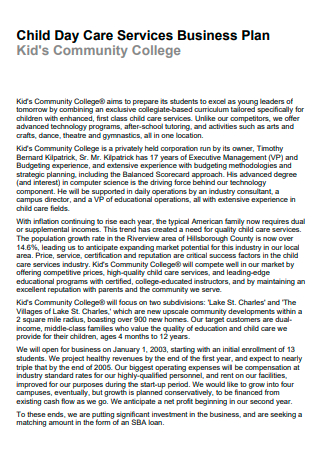
Child Day Care Services Business Plan

Child Care Center Developing Business Plan
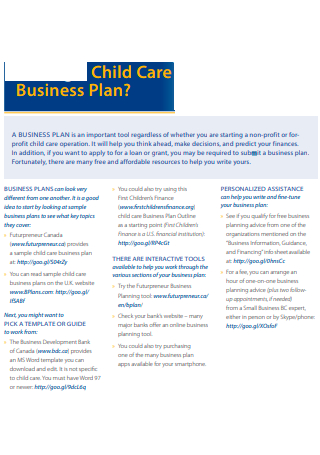
Child Care Business Plan Example
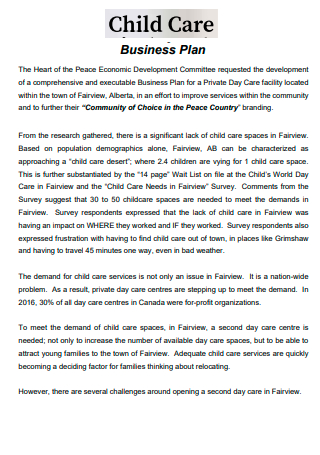
Standard Child Care Business Plan

Registered Family Child Care Business Plan
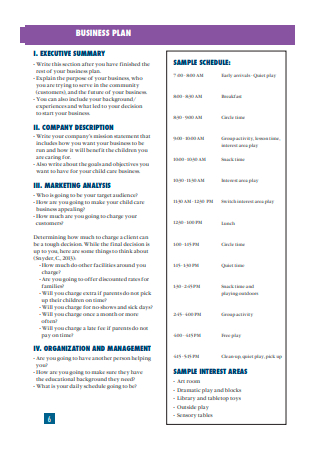
Child Care Business Plan in PDF
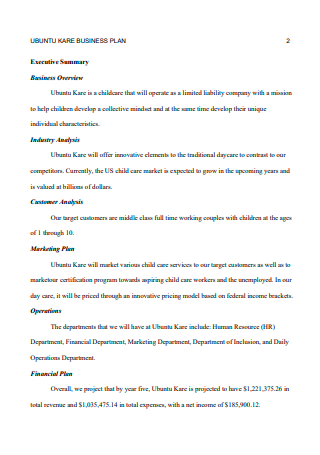
Printable Child Care Business Plan
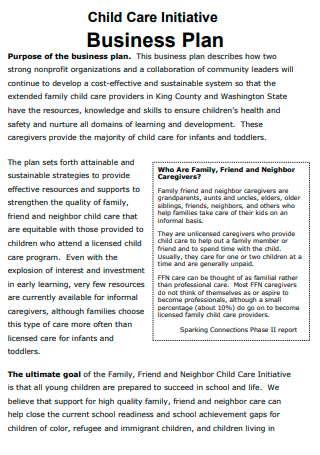
Child Care Initiative Business Plan
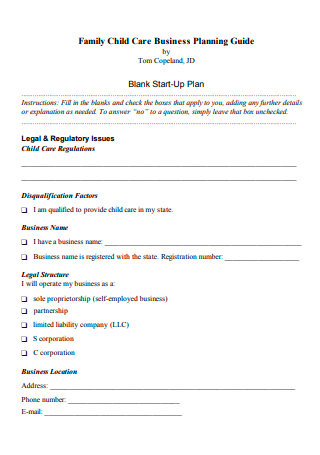
Family Child Care Business Planning

Child Care Development Center Business Plan
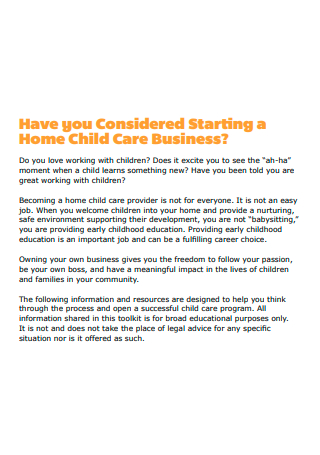
Home Child Care Business Plan
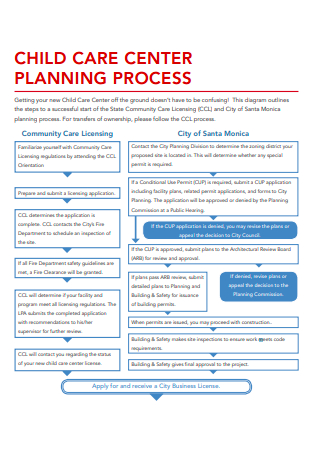
Child Care Center Business Planning Process

Child Care Program Business Plan
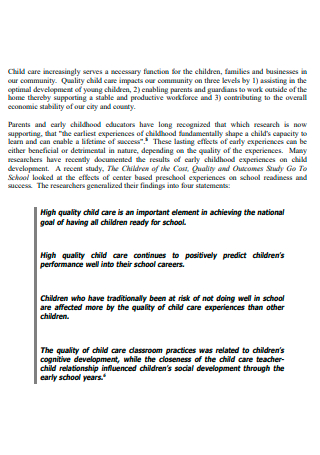
Sample Child Care Business Plan
1. analyze the target market and start with the basics., 2. assess the needs of your business., 3. write down the parts of the plan and advertise it., 4. proofread and polish the business plan., share this post on your network, you may also like these articles.

In this comprehensive guide, we explore the essentials of creating an effective Floor Plan. Whether you are designing a new home, renovating an existing space, or planning an office…
Nursing Care Plan

In this comprehensive guide, we explore the essentials of creating an effective Nursing Care Plan. Whether you are a nursing student, a new graduate, or an experienced nurse, this…
browse by categories
- Questionnaire
- Description
- Reconciliation
- Certificate
- Spreadsheet
Information
- privacy policy
- Terms & Conditions
Daycare business plan template + PDF
This guide presents a groundbreaking AI Business Plan Generator template, specifically tailored for entrepreneurs looking to start or expand their daycare operations. It's important to emphasize that the names and financial forecasts included in this example are solely for illustrative purposes, acting as educational tools to assist you in navigating your business planning journey. These examples are meticulously chosen to illustrate how you can personalize your own AI-generated Daycare Business Plan, enabling you to tackle challenges and capitalize on opportunities within the daycare industry.
For those in search of a customized solution, we provide a downloadable 'Daycare Business Plan PDF' . This document is indispensable for entrepreneurs dedicated to crafting a persuasive and effective strategy for launching or enhancing their daycare business. The 'AI Business Plan Generator' serves as a detailed guide, offering profound insights into the daycare market. It arms you with the necessary tools to adeptly manage and develop your daycare business, harnessing the power of AI for unmatched strategic planning.

How this daycare business plan sample was created
Easily craft your tailored daycare business plan with our AI Business Plan Generator. Just click 'Generate your business plan' and respond to a series of targeted questions about your daycare initiative. Our advanced AI technology will analyze your answers to create a business plan that aligns perfectly with the objectives and needs of your daycare business. This effective and straightforward method takes only 5-10 minutes, yielding a comprehensive and well-structured plan. Our platform enables modifications and fine-tuning of your plan, making sure it precisely represents your unique vision for your daycare enterprise. Upon completion, your plan is ready for download, providing a clear and detailed roadmap for starting and growing your daycare business. Tap into the power of our AI business plan generator, specifically designed for daycare businesses, to enhance your strategic planning activities.

Daycare business plan sample
Executive summary, business description, market research and analysis, swot analysis.
- Organizational Structure and Management Team
Products or Services
Marketing and sales strategy, operations plan, financial projections, risk analysis.

Little Explorers Daycare, nestled in the heart of a bustling California community, stands as a model of excellence in early childhood care and education. Founded in 2020 by a visionary team led by Samantha Lewis, our state-of-the-art facility offers a sanctuary of learning and growth for children aged 6 months to 5 years. This executive summary provides an overview of our business plan, outlining our mission, operations, financial outlook, and the strategic steps we are taking to solidify Little Explorers Daycare’s position as a leader in the childcare industry.
Mission and Vision
Our mission at Little Explorers Daycare is to provide a safe, nurturing, and intellectually stimulating environment that fosters the holistic development of our young learners. We aim to be a haven where the natural curiosity of children is ignited, and their early learning milestones are achieved with joy and enthusiasm. Our vision extends beyond daycare; we strive to be the cornerstone of our community’s early childhood education, building strong foundations for a lifetime of learning.
Products and Services
Little Explorers Daycare offers both full-day and half-day programs tailored to meet the needs of working parents and guardians. Our services are distinguished by an innovative curriculum that includes language development, social skills enrichment, and introductory STEM activities. We pride ourselves on creating an educational experience that blends learning with play, ensuring that every child’s first educational journey is engaging and rewarding.
Market Analysis
The demand for quality childcare services in California continues to grow, driven by increases in dual-income households and the recognition of early childhood education's importance. Our target market includes working parents and guardians in the local area, a demographic that values the balance of educational programming and flexible childcare solutions. In response to these needs, Little Explorers Daycare offers a unique value proposition by combining high-quality care with an exceptional early learning curriculum.
Organizational Structure and Management
Our management team, led by Director Samantha Lewis, brings together expertise in early childhood education, business administration, and health and safety management. Alongside Jessica Clark (Assistant Director), Michael Thompson (Operations Manager), and Elena Rodriguez (Health & Safety Coordinator), the team is committed to upholding the highest standards of daycare operations. This dedicated leadership underpins our operational excellence and commitment to the well-being and education of the children we serve.
Little Explorers Daycare’s marketing strategy is centered on digital outreach, community engagement, and building trust through word-of-mouth recommendations. A robust online presence, coupled with partnerships with local businesses and schools, positions us to attract and retain clientele. Our sales strategy relies on personalized tours, open houses, and responsive communication, ensuring that the unique benefits of our programs are communicated effectively to prospective families.
Our financial outlook is optimistic, with projections indicating steady revenue growth of 12% annually over the next five years. By year three, we anticipate revenues of $750,000, with profitability margins expanding to 25% as operational efficiencies are realized. Investments in facility enhancements and program expansions are planned, funded by a mix of retained earnings and potential financing options. We are strategically positioned for the addition of a second location in year four, which is expected to double our revenue capacity by year five.
We have identified and developed strategies to mitigate various risks, including market competition, operational challenges, and regulatory compliance. Our comprehensive insurance coverages, stringent health and safety protocols, and proactive management practices form a robust framework for risk mitigation and operational resilience.
In conclusion, Little Explorers Daycare is poised for significant growth and impact in the early childhood education sector. Our commitment to excellence, combined with strategic planning and a dedicated team, ensures that we will continue to offer unparalleled care and educational services to the families we serve. Our business plan lays the foundation for a bright future, where Little Explorers Daycare stands as a beacon of learning, growth, and community engagement.

Little Explorers Daycare, nestled at the lively heart of 123 Childhood Lane, is uniquely designed to serve as a home away from home for children aged 6 months to 5 years. As a beacon of early childhood education and care in California, Little Explorers operates in the dynamic daycare industry, a sector pivotal to modern society. This industry not only allows parents and guardians to pursue their careers with peace of mind but also plays a crucial role in the foundational development of future generations.
Since its inception in 2020, Little Explorers Daycare has been driven by a singular purpose: to blend nurturing care with early education, creating a rich environment where young minds can explore, learn, and grow. Our journey began when a group of passionate educators, led by Samantha Lewis, recognized a significant gap in quality childcare and early childhood education services. Witnessing working parents' struggles to find satisfactory daycare solutions that also offered educational enrichment, Little Explorers was founded to meet these needs. The daycare was envisioned not just as a facility for child minding but as an educative oasis where each child’s intellectual, social, and emotional abilities could flourish.
Our mission, to foster a love for learning among the youngest members of our community, guides every aspect of our operations. Little Explorers is committed to creating a safe, engaging, and nurturing environment that supports each child's holistic growth. This mission is imbued in our comprehensive childcare and early education programs, designed to prepare our little explorers for a seamless transition into the formal schooling system.
Structured as a Limited Liability Company (LLC) within the state of California, Little Explorers Daycare combines the operational flexibility of a small business with the protective regulatory framework afforded by its legal structure. This choice reflects our commitment to providing a reliable service to our clients while affording us the stability to innovate and expand our educational offerings.
The long-term potential of Little Explorers Daycare is buoyant, driven by several key factors. Firstly, the continuous demand for high-quality daycare services, spurred by rising numbers of both parents entering the workforce, underscores the essential role of daycares in modern society. Moreover, as awareness grows of the critical impact of early childhood education on later academic and social success, parents increasingly seek out programs that offer more than basic childcare. Little Explorers stands at the vanguard of this emerging trend, offering specialized programs that set children on a path of lifelong learning and curiosity.
In the coming years, Little Explorers Daycare aims to broaden its impact through the introduction of innovative educational programs, expansion to new locations, and the adoption of technology in early learning. As part of our strategic plan, we also aim to deepen our ties with the local community, reinforcing our commitment to being a supportive partner for families. The business sees itself not just as a daycare provider but as a cornerstone of community development, contributing to the well-being and growth of local families.
At its core, the potential of Little Explorers transcends the boundaries of traditional daycare services. By intertwining care with education, and supporting working families, we are setting the stage for a brighter future. Our vision extends beyond the immediate horizon, aiming to enrich lives, empower parents, and inspire the next generation of thinkers, leaders, and, above all, lifelong explorers.
The daycare industry is a crucial component of the modern economic structure, enabling parents and guardians to participate in the workforce while providing a nurturing and educational environment for their children. The sector has seen substantial growth due to increasing demand from working families, coupled with a growing recognition of the importance of early childhood education. Current trends indicate an expanding market, with an annual growth rate of approximately 3%. This growth is in part driven by societal shifts, including increases in dual-income households and a greater focus on the developmental benefits of early education programs.
The target market for Little Explorers Daycare encompasses working parents and guardians of children aged 6 months to 5 years old. Within the geographical area of California, where Little Explorers is located, this demographic is significant and growing. The increasing participation of women in the workforce, combined with the rising number of young families moving to urban and suburban areas for employment opportunities, amplifies the demand for daycare services. The target market is further defined by parents who value educational development as a core component of childcare. This group's size and growth potential mirror broader demographic trends, including urbanization and workforce participation rates, positioning Little Explorers in a market with strong expansion potential.
Market needs and demands within the daycare industry are multifaceted. Parents and guardians seek reliability, safety, and a nurturing environment for their children. Additionally, there is an increasing demand for educational programming that supports early childhood development, focusing on language acquisition, social skills, and introductory concepts in math and science. These needs are driven by a heightened awareness of the importance of early learning stages in shaping cognitive and social abilities. Market trends also point towards a preference for facilities that offer flexible scheduling options, recognizing the varied work hours of modern families. The integration of technology in educational programming and communication between daycare staff and parents is another emerging trend, reflecting broader digital transformation across industries.
In the competitive landscape, Little Explorers Daycare faces established players like Tiny Tots Childcare, Bright Horizons Family Solutions, and Kiddie Academy. These competitors have diverse strengths, such as extensive networks and brand recognition (Bright Horizons), innovative curriculum (Kiddie Academy), and localized community engagement (Tiny Tots Childcare). However, weaknesses such as higher pricing models, less personalized care due to larger size, and outdated curriculum models present opportunities for Little Explorers to differentiate itself by emphasizing personalized attention, competitive pricing, and modern, innovative educational content.
Despite the promising market conditions, potential barriers to entry include stringent regulatory requirements, the high initial capital investment needed for facility setup and licensing, and the challenge of building a reputation in a market with established players. Compliance with local and state regulations is both a barrier and an ongoing operational consideration, requiring meticulous attention to policy changes and standards in health, safety, and educational content. The competitive environment demands differentiation and a clear value proposition to carve out market share. For Little Explorers Daycare, overcoming these barriers involves leveraging the unique qualifications of its management team, focusing on niche educational programs, and establishing strong community ties to build trust and brand recognition.
In conclusion, the daycare industry's robust growth and the specific demands of our target market represent a fertile ground for the expansion of Little Explorers Daycare. By addressing the nuanced needs of modern families and navigating the competitive landscape with strategic focus, Little Explorers is positioned to become a leading provider of childcare and early education services in California.

| Strengths | Weaknesses |
|---|---|
| Little Explorers Daycare boasts a distinctive combination of strengths that set it apart in the competitive daycare industry. First, our highly qualified management team brings a wealth of experience in early childhood education, operations management, and health and safety practices, ensuring a well-rounded approach to childcare. Additionally, we offer a unique blend of educational programs that integrate early learning standards with innovative activities designed to engage and stimulate young minds. Our commitment to maintaining a low staff-to-child ratio guarantees personalized attention and care, fostering a nurturing environment that supports the developmental needs of each child. Furthermore, our robust health and safety protocols adhere to and exceed industry standards, providing parents with peace of mind and setting a benchmark for operational excellence. | Despite our strong positioning, Little Explorers Daycare faces certain weaknesses that could impact our competitive advantage. One of the primary challenges is the relatively new presence in the market, which means we are still in the process of building our reputation and trust within the community. Additionally, our |
| Opportunities | Threats |
| The daycare industry is ripe with opportunities for growth and innovation that Little Explorers Daycare is well-positioned to capitalize on. Expanding our services to include after-hours care, weekend programs, and summer camps can address the needs of working parents seeking more flexible childcare solutions. Furthermore, there is potential for geographic expansion by opening additional locations in neighboring communities or areas experiencing growth in young families. Implementing technology-driven learning and communication tools represents another opportunity to enhance our educational offerings and streamline operations. Finally, forging partnerships with local businesses and schools can expand our network and referral base, driving enrollment and building our brand presence in the community. | The daycare industry, while offering substantial growth opportunities, also presents several threats that could impede the success of Little Explorers Daycare. Chief among these is the intensifying competition from both established chains and new entrants, which could erode our market share and pressure pricing. Regulatory changes pose another significant threat, as increased compliance costs or adjustments to licensing requirements could impact our operational model. Additionally, economic fluctuations can affect |
Little Explorers Daycare operates under a structured organizational framework designed to ensure effective service delivery, operational efficiency, and a nurturing environment for the children under our care. At the core of our organizational structure is a clear hierarchy that promotes smooth communication and swift decision-making processes.
The hierarchy is spearheaded by the Director, Samantha Lewis, who brings over 15 years of experience in early childhood education and a Master's degree in Education Management. Samantha is responsible for setting strategic goals, overseeing all operations, and ensuring compliance with regulatory standards. Reporting directly to the Director are the Assistant Director, Operations Manager, and Health & Safety Coordinator, each overseeing distinct aspects of the daycare's functioning.
Jessica Clark, the Assistant Director, holds a Bachelor's degree in Early Childhood Education and has been integral to curriculum development and staff training for the past 10 years. She collaborates closely with the Director to implement educational programs and manage teaching staff.
The Operations Manager, Michael Thompson, with a background in Business Administration, manages the day-to-day logistics, including scheduling, facility maintenance, and finance management. His role is crucial for the seamless operation of the daycare.
Elena Rodriguez, as Health & Safety Coordinator, utilizes her extensive background as a registered nurse to ensure the health and safety protocols are rigorously upheld, creating a secure environment for both staff and children.
On the staffing front, Little Explorers currently employs 10 certified childcare providers, including two educational program coordinators and seven childcare staff members. As we anticipate enrollment growth, we project the need to hire additional staff, including three more childcare providers and an additional educational program coordinator within the next year. Maintaining a low staff-to-child ratio is paramount to provide personalized and attentive care, necessitating our thoughtful approach to staffing as we expand.
In terms of human resources policies and practices, Little Explorers places a high premium on continuous professional development, offering regular training and workshops for all staff members. Our comprehensive benefits package includes health insurance, paid time off, and retirement savings plans, reflecting our commitment to attracting and retaining top talent. Performance evaluations are conducted bi-annually, serving as a basis for promotions, salary adjustments, and personal development planning.
Furthermore, Little Explorers engages a range of external advisors and consultants to ensure best practices across all operations. A legal advisor specializing in childcare licensing and employment law provides ongoing consultation to keep us abreast of regulatory changes. An early childhood education consultant assists in curating and updating our educational programs, while a health and safety consultant evaluates our protocols and training programs annually.
Our organizational structure, underpinned by a talented management team and supported by comprehensive HR policies and external expertise, forms the backbone of Little Explorers Daycare. This structure not only facilitates our day-to-day operations but also strategically positions us for successful expansion and the continuous delivery of high-quality care and education. As we look to the future, we remain committed to investing in our staff, refining our organizational practices, and relentlessly pursuing our mission of fostering a love of learning among the children we serve.

Little Explorers Daycare is dedicated to providing comprehensive early childhood care and education services that support the developmental needs of children aged 6 months to 5 years. Our services are meticulously structured to ensure a balanced approach to learning, play, and rest, in line with the latest research in early childhood development.
Detailed Description of Products or Services
Little Explorers Daycare offers full-day and half-day childcare services. The full-day service runs from 7:00 AM to 6:00 PM, while half-day options are available either in the morning or the afternoon. Each day is structured around a blend of educational activities, free play, nap time, and meal times, designed to promote cognitive, social, and physical development. Our early childhood education programs focus on foundational skills such as language development, basic mathematics, and social skills. These programs are tailored to the age group and developmental stage of each child, ensuring a personalized learning experience.
Unique Selling Points or Competitive Advantages
Little Explorers Daycare’s competitive advantage lies in our holistic approach to early childhood education. Unlike traditional daycares that focus primarily on supervision, we offer an integrated curriculum that fosters early literacy, numeracy, and emotional intelligence. Our unique selling propositions include:
1. Qualified Staff: Our team of educators and caregivers are certified and have specialized training in early childhood education. 2. Low Staff-to-Child Ratios: We ensure personalized attention and tailored instruction by maintaining lower ratios than the state-mandated guidelines. 3. Innovative Curriculum: We employ a curriculum that incorporates emergent learning principles, STEM activities, and bilingual education (Spanish/English), setting us apart from competitors. 4. Focus on Well-being: We prioritize children's physical and emotional well-being, offering nutritious meals prepared on-site and integrating mindfulness and yoga into our daily routine.
Development Stage
Currently, Little Explorers Daycare operates one facility, serving approximately 60 children. We are in the process of expanding our premises to accommodate up to 90 children within the next two years. Future plans include the introduction of an outdoor learning environment to enhance our curriculum with nature-based educational experiences.
Intellectual Property Status
Although childcare services do not traditionally rely on patents, Little Explorers is in the process of trademarking its name and logo to protect our brand identity. Furthermore, we are developing proprietary educational materials and assessment tools for our curriculum. Once finalized, these materials will be copyrighted, ensuring that Little Explorers maintains exclusivity over our innovative teaching resources.
Production Process
Our “production process” involves the careful planning and execution of daily schedules and activities designed to meet our educational objectives. This process requires ongoing collaboration among our staff to adapt our curriculum and activities to the evolving needs and interests of the children in our care.
Supplier Information
Our commitment to high-quality care extends to our choice of suppliers. We source our educational materials from reputable vendors known for their innovative and child-friendly products. Our meal ingredients are purchased from local, organic providers, ensuring that the children receive nutritious, well-balanced meals. We maintain strong relationships with our suppliers, ensuring the reliability and quality of the products and services we depend on.
In conclusion, Little Explorers Daycare stands out in the competitive landscape of childcare services through our commitment to early childhood education, unique curriculum, and focus on the holistic development of children. As we advance, we remain dedicated to enhancing our services, exploring new educational initiatives, and expanding our capacity to meet and exceed the expectations of the families we serve.
Little Explorers Daycare's marketing and sales strategy are crafted to effectively communicate our value proposition to our target audience: working parents and guardians of children aged 6 months to 5 years. Our strategy integrates a blend of digital and community outreach efforts, emphasizing our unique selling points such as innovative educational programs, a nurturing environment, and a skilled, caring staff.
Marketing Strategy
Our marketing strategy is multifaceted, focusing on online presence, community engagement, and building strong word-of-mouth referrals.
- Digital Presence: We will leverage a comprehensive digital marketing approach, including an SEO-optimized website that provides detailed information about our programs, staff qualifications, and testimonials from satisfied parents. Social media platforms like Facebook and Instagram will be utilized to share engaging content, including highlights from our daily activities, educational tips for parents, and promotional offers.
- Local Community Engagement: Partnering with local businesses, schools, and healthcare providers, we plan to participate in community events and sponsor child-friendly activities, thereby increasing brand visibility. Cross-promotional partnerships will place our brochures and flyers in strategic locations frequented by our target demographic.
- Referral Program: Encouraging our existing customer base to refer new clients through incentives, such as discounts or complimentary add-on services, capitalizes on the trust we've built with them and leverages their networks to expand our reach.
Sales Strategy
Our sales approach is centered on creating personalized experiences for prospective clients. The strategy includes:
- Open Houses and Scheduled Tours: Interested parents will be invited to visit the facility, where they'll meet with staff members, including the Director, to discuss their child's needs and our educational philosophy. This face-to-face engagement is crucial for building trust and understanding the unique value Little Explorers offers.
- Follow-up Communications: After initial visits or inquiries, prompt and personalized follow-up communications will be conducted via email or phone to address any questions and encourage enrollment.
- Enrollment Process Simplification: Making the enrollment process as smooth as possible by providing clear, concise information and support throughout the decision-making process.
Pricing Strategy
Pricing at Little Explorers is designed to be competitive yet reflective of the premium service we offer. We will implement a tiered pricing model based on the type of service (full-day vs. half-day), with discounts for siblings and long-term commitments to enhance affordability for families.
Distribution Channels
Our primary "distribution channel" is the direct service we provide to children and their families. We also consider our website and social media platforms as virtual channels, where parents can gather information, read reviews, and initiate contact.
Promotion and Advertising Plans
Promotional efforts will include targeted online advertising through Google Ads and social media platforms, aimed at reaching parents in our geographic locale. Seasonal promotions and open house events will also serve as key advertising opportunities, supplemented by participation in local community events that allow for direct engagement with potential clients.
Customer Service Policies
Customer satisfaction is paramount, and our policies reflect a commitment to exceptional service:
- Open Communication: Keeping lines of communication open with regular updates on children's progress and day-to-day activities.
- Feedback Mechanisms: Implementing regular surveys and suggestion boxes, ensuring parents feel heard and involved.
- Conflict Resolution: Establishing a clear, fair process for addressing concerns or complaints, ensuring timely and satisfactory resolutions.
Through this comprehensive marketing and sales strategy, Little Explorers Daycare aims to grow its customer base, maintain high levels of client satisfaction, and establish itself as a leader in early childhood education and care within the community.

Little Explorers Daycare’s Operations Plan outlines the daily operational workflow and procedures designed to ensure the consistent delivery of high-quality childcare and early childhood education services. Our approach prioritizes the safety, well-being, and developmental progress of the children in our care, efficiently manages resources, and maintains a welcoming and stimulating environment.
Operational Workflow
Each day at Little Explorers Daycare begins with the opening procedures which include facility safety checks, preparation of learning materials, and a review of the day’s activities by the staff. Following the arrival of children, the schedule is structured around a series of educational programs, playtime both indoor and outdoor, meals, naps, and individual learning sessions. The day concludes with a thorough review of the day’s activities, parent feedback during pickup, and facility cleanup.
The operational workflow is supported by our dedicated staff, including childcare providers, educational program coordinators, and facility maintenance personnel. Staff assignments are structured to ensure a consistent child-to-staff ratio, allow for personalized attention, and facilitate the smooth transition between daily activities.
Production or Service Delivery Processes
Our service delivery process begins with the enrollment of a child, involving a comprehensive assessment to understand the child’s needs, preferences, and developmental stage. This assessment informs the child’s integration into our programs, ensuring they are placed in activities and educational sessions that match their developmental needs.
Regular progress assessments are conducted to adapt educational content and care approaches as children grow and their needs evolve. These assessments involve direct observations, developmental screenings, and parent consultations, providing a holistic view of each child’s progress.
Quality Control Measures
Quality control is paramount in our operations. We adhere to state regulations and quality standards in early childhood education and care, employing only certified childcare providers and continuously training our staff. Our educational programs are regularly reviewed and updated based on the latest research in childhood education and feedback from parents and staff.
Internal quality audits are conducted monthly, focusing on safety protocols, the effectiveness of educational programs, child engagement levels, and parent satisfaction. The findings of these audits inform continuous improvement efforts.
Inventory Management
Inventory management involves regular monitoring and replenishment of educational materials, toys, and supplies necessary for daily operations. A designated staff member is responsible for inventory tracking, routinely assessing the condition and quantity of items, and placing orders for replacements or new resources to support our curriculum.
Supply Chain Management
Our supply chain consists of local and specialized suppliers for educational materials, food, and operational supplies. We prioritize suppliers who share our commitment to quality, sustainability, and reliability. Relationships with suppliers are managed through regular meetings, contract reviews, and performance evaluations, ensuring our supply chain supports our operational needs without interruption.
Facilities and Equipment Needs
Our facility is designed to foster a safe, engaging, and comfortable environment for children, including multiple classrooms, a play area, a nap room, and dining area. Keeping our facilities up-to-date requires ongoing maintenance and the occasional acquisition of new equipment. Future plans include expanding our outdoor play area and integrating new technology into our educational programs, necessitating investments in tablets and educational software.
Efficiently managing our operations ensures that Little Explorers Daycare consistently delivers the high-quality care and educational enrichment that parents expect. Our operational plan is designed to be flexible, allowing us to adapt to the changing needs of the children we serve and the dynamic nature of the childcare industry.
In this section of the business plan, we outline the financial projections for Little Explorers Daycare over the next three to five years. These projections are based on a comprehensive analysis of our market potential, operational efficiency, and strategic growth plans. Our goal is to provide a transparent and realistic view of our financial performance and potential, setting the stage for sustained profitability and growth.
Sales Forecast
Over the next five years, we anticipate a steady increase in sales revenue, with an annual growth rate of 12%. This projection is based on expanding enrollment as we enhance our programs and increase our marketing efforts to reach more families. By year three, we expect to reach full capacity with a projected enrollment of 90 children, contributing to a significant boost in sales revenue. The introduction of additional services, such as after-hours care and weekend programs, in year four is expected to further augment our sales.
Profit and Loss Projection
Our profit and loss projection indicates a gradual increase in net profits over the next five years. Initial years will focus on solidifying our market presence and may see tighter margins due to start-up costs and initial investments in marketing and facility enhancements. By year two, as enrollment stabilizes and operational efficiencies are realized, we expect to see an increase in gross margin. Operating expenses, including salaries, facility maintenance, and marketing, are projected to grow in line with revenue, maintaining a consistent ratio. Net profits are expected to rise from 10% in the first year to 25% by year five as a result of increased revenue and stabilized costs.
Cash Flow Projection
Cash flow projections show positive net cash flow starting from year one, further improving as operational efficiencies take effect and revenue from enrollments increases. Adequate cash reserves will be maintained to manage operational expenses and support facility expansions and improvements. Investments in curriculum development and staff training are planned, with the anticipation that these investments will yield higher enrollment and retention rates.
Balance Sheet Projection
The balance sheet projection reflects a strengthening financial position over the next five years. Assets, including cash, facilities, and educational materials, will grow proportionally with our business expansion. Liabilities, primarily consisting of loan repayments for initial start-up costs, will decrease as we prioritize debt repayment in our financial strategy. Equity is expected to increase steadily as retained earnings grow, reflecting the overall financial health and stability of Little Explorers Daycare.
Break-even Analysis
Our break-even analysis indicates that we will reach the break-even point towards the end of the first year. This analysis is based on fixed costs, variable costs per child, and the average revenue per child. Managing operational efficiencies and maintaining competitive pricing will be key to reaching our break-even point as forecasted.
Financial Assumptions and Considerations
Several key assumptions underpin our financial projections:
- Market demand for daycare services in our target area remains strong, with growth driven by increases in working parents. - Operational efficiencies will be realized through strategic staffing, inventory management, and cost-effective marketing. - Enrollment will reach full capacity by year three following a targeted marketing strategy and expansion of services. - Initial investments in facilities and curriculum development will enhance our competitive advantage and contribute to long-term profitability.
External factors, including economic conditions and regulatory changes, are also considered in our financial planning. We have instituted conservative financial practices to ensure resilience in face of economic uncertainties.
In conclusion, the financial projections for Little Explorers Daycare suggest robust growth and profitability over the next five years. Our strategic approach to business development, combined with a strong market demand and operational efficiencies, positions us well for financial success.

In any business venture, especially in a sensitive sector like childcare, understanding and preparing for potential risks is crucial for sustainability and growth. This section identifies key risks Little Explorers Daycare may face and outlines strategies to mitigate these risks, ensuring the long-term success of our daycare.
Market Risks
Market risks include fluctuations in demand, increased competition, and changes in parent preferences and regulations that govern daycare operations.
- Mitigation: Continuously monitor market trends and regulatory changes to adapt our programs and services in real-time. Investing in market research helps understand parent preferences and anticipate shifts in demand. Diversify service offerings (after-hours care, weekend programs) to attract a broader clientele. - Contingency Plan: Develop partnerships with local businesses and community organizations to maintain a steady pipeline of potential clients. Implement a robust marketing strategy to adjust to changes in demand or competition.
Operational Risks
Operational risks encompass staff turnover, accidents or health issues among children, and potential disruptions from facility-related issues (maintenance, safety).
- Mitigation: Implement stringent hiring practices and offer competitive salaries and professional growth opportunities to reduce staff turnover. Adhere to high safety and health standards, regularly train staff on emergency response, and maintain a clean and well-maintained facility. - Contingency Plan: Establish a qualified pool of substitute staff. Have agreements with local health professionals for emergency support. Maintain an adequate reserve fund for unforeseen facility repairs or upgrades.
Financial Risks
Financial risks involve managing costs, ensuring profitability, and securing funding for operations and expansions.
- Mitigation: Careful financial planning and management, including monitoring cash flow closely, implementing cost-saving measures, and maintaining a contingency fund. Develop relationships with financial institutions for potential financing options. - Contingency Plan: Diversify revenue streams by offering additional services such as family workshops, parental counseling, or educational resources. Responsive pricing strategies can adjust to market changes without compromising service quality.
Legal and Compliance Risks
Staying compliant with state and federal regulations for childcare facilities, including licensing, staff qualifications, and child-to-staff ratios.
- Mitigation: Employ a legal advisor to ensure ongoing compliance with all regulations. Regularly review and update policies and procedures to adhere to the latest laws. - Contingency Plan: Allocate resources for legal defense and compliance adjustments as necessary. Hold regular training sessions to keep staff updated on regulatory changes and implications for daily operations.
Health and Safety Risks
Risks involving the spread of illnesses, accidents, or injuries occurring on the premises.
- Mitigation: Implement and enforce stringent health and safety protocols, including regular health checks, a clean and safe environment, and immediate reporting and addressing of any incidents. - Contingency Plan: Establish partnerships with healthcare providers for emergency situations. Have a clear communication plan in place for notifying parents and relevant authorities about health or safety incidents.
Insurance and Legal Considerations
Comprehensive insurance coverage is critical to protect against potential liabilities. Little Explorers Daycare will maintain insurance policies covering health and safety liabilities, property damage, and staff-related issues.
- Legal Considerations: Regularly consult with a legal advisor to navigate the complexities of childcare law, employee relations, and contract management, ensuring all aspects of operations are legally sound.
In summary, while Little Explorers Daycare faces various potential risks, our proactive mitigation strategies and contingency plans are designed to navigate these challenges effectively. By staying informed, flexible, and committed to our core values and operational excellence, we can safeguard our business against unforeseen difficulties and ensure a secure and thriving environment for the children under our care.

More business plan templates
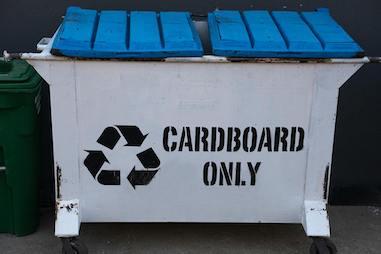
Junk removal business plan

Family entertainment center business plan

Coffee shop business plan
All Formats
Plan Templates
9+ editable daycare business plan templates.
Infants and toddlers are fragile, little saplings who need the utmost care and affection. Being able to take care of them well positively affects their holistic growth and even their well-being when they grow up. Unfortunately, not all parents can give their children the attention they need. Some kids are left with nannies who may not have any genuine concern for them. You may also see Daycare Business Plans .

Editable Daycare Business Plan Template
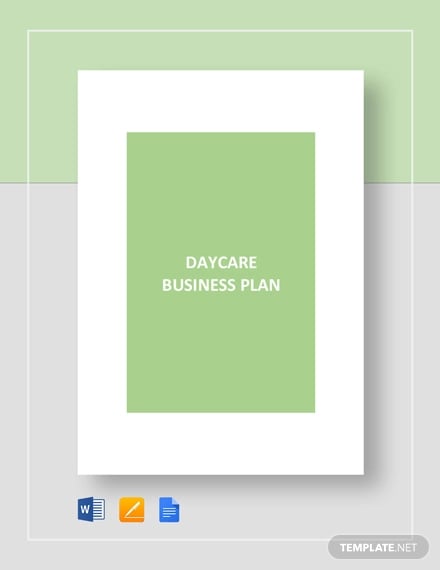
- Google Docs
Animal Day Care Business Plan Template
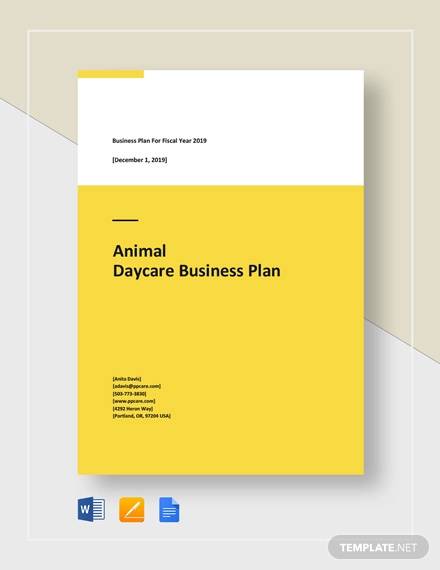
Free Editable Pet Day Care Business Plan Template
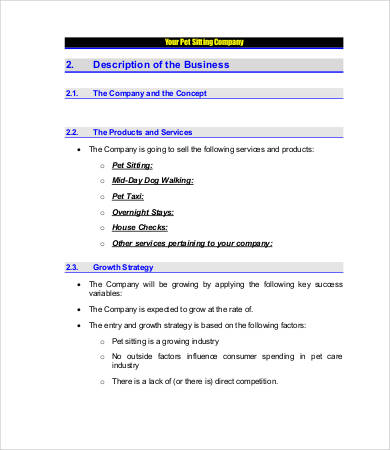
Free Editable Child Day Care Services Business Plan
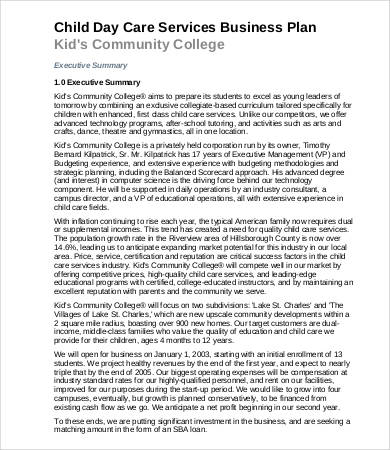
Free Day Care Center Business Plan Template
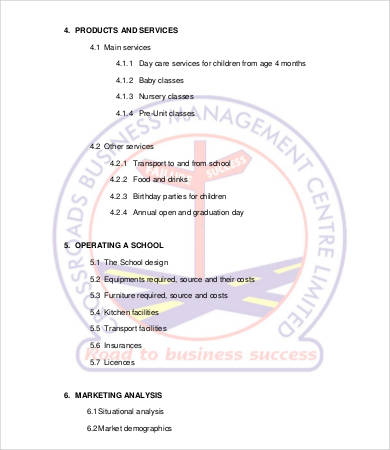
Starting a Daycare Center
- M ake a needs analysis. Identify which children in your area particularly needs.
- Observe the market. Do benchmarking and observe how competitors run their daycare centers.
- Careful planning. Create a simple business plan and identify the type of daycare center you want to start. Also, include a Marketing Business Plan and other financial plans .
- Name and place. Come up with a name and decide on the ideal location.
- Secure all paperwork. Acquire the needed requirements mandated by the government.
- Secure equipment and staff. Set up your childcare center and purcha s e all the equipment and furniture you need. Hire employees and conduct an orientation.
- Comply with basic rules and regulation. Make sure the entire premises is well-monitored and ready for inspection.
- Advertise. Promote your new business using your planned marketing strategy .
- Start enrollment or registration.
- Open your business with flare. You can offer goodies for both children and parents.
- Check on different aspects of the business regularly.
Free Family Day Care Business Marketing Plan
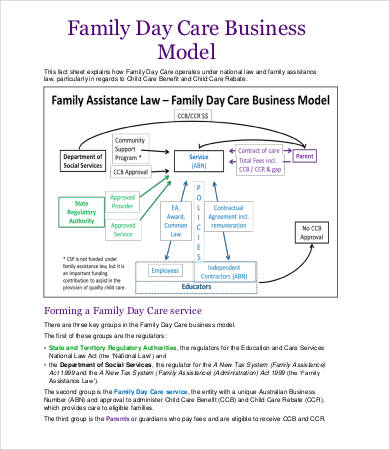
Free Kids Day Care Business Plan Template
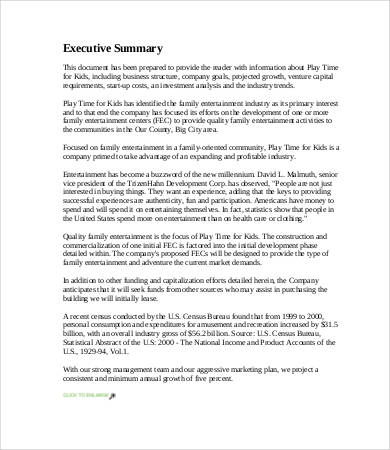
Free Editable Home Day Care Business Plan Template
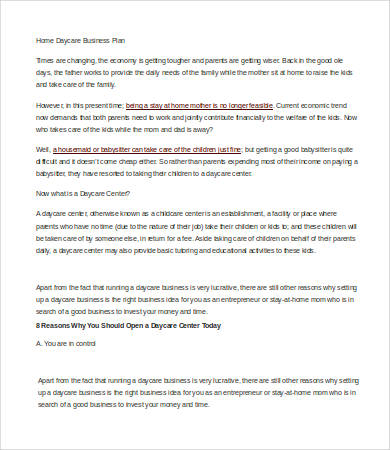
Free Senior Day Care Center Business Plan Template
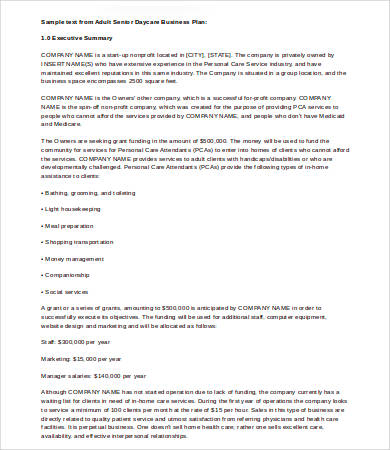
Build and Maintain a Thriving Business
- Be creative. You are establishing a center for kids. Every day should be exciting for them.
- Be socially active. Engage in conversations with your employees, kids in their sessions, and even the parents. The more you build rapport, the more comfortable they are in your center.
- Ask for feedback . The best way for the business to develop better is to ask for feedback survey and evaluate your business’s performance.
- Keep focused on the goal. Set your drive geared towards the purpose you built the center in the first place.
- Great service for every client. Treat every kid and parent with great compassion. Give them more than they expected. You can also see more on Hotel Business Plans .
More in Plan Templates
Basic Business Activity Plan Template
Small business startup business plan template, one page business plan template, small business plan template, business plan template, startup business plan template, business plan format template, sample business plan template, simple business plan template, business plan outline.
- 7+ Financial Plan Templates
- 10+ Operational Plan Templates
- 9+ Training Plan Templates
- 5+ Shooting Schedule Template
- 11+ School Counselor Lesson Plan Templates in PDF | Word
- 9+ Interdisciplinary Lesson Plan Templates in PDF | MS Word
- 10+ Business Continuity Plan Templates in Google Docs | Ms Word | Pages | PDF
- 18+ Compensation Plan Templates in Google Docs | MS Word | Pages | PDF
- 10+ Executive Bonus Plan Templates in PDF
- 8+ Facility Management Plan Templates in PDF
- 10+ Diversity Recruitment Plan Templates in PDF | MS Word
- 11+ Audit Corrective Action Plan Templates in MS Word | Excel | PDF
- 9+ Recruitment Agency Marketing Plan Templates in PDF
- 10+ Recruitment Marketing Plan Templates in PDF | MS Word
- 10+ Student Recruitment Plan Templates in PDF | MS Word
File Formats
Word templates, google docs templates, excel templates, powerpoint templates, google sheets templates, google slides templates, pdf templates, publisher templates, psd templates, indesign templates, illustrator templates, pages templates, keynote templates, numbers templates, outlook templates.

Daycare Business Plan

As a lot of toddlers turn to preschool age, the number of enrollees in daycare also increases. As a businessman, you should see this as an opportunity. Parents spend a great deal of time selecting the best daycare for their sons or daughters. Composing a daycare business plan will keep you one step ahead of your competitors.
6+ Daycare Business Plan Examples
1. daycare business plan template.

- Google Docs
2. Animal Day Care Business Plan
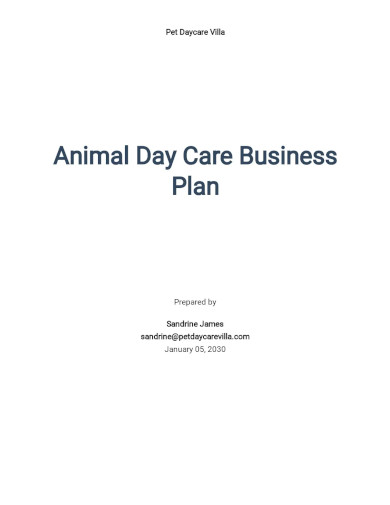
3. Child Care Business Plan Template
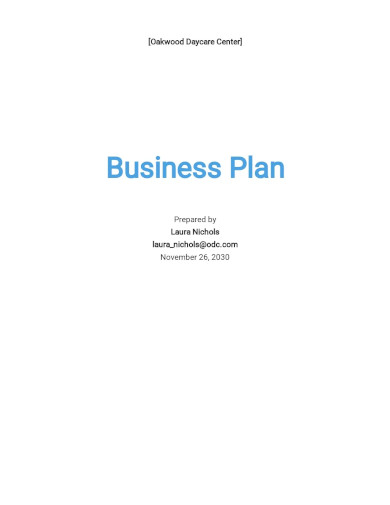
4. Daycare Center Business Plan

Size: 395 KB
5. Day Care Services Business Plan
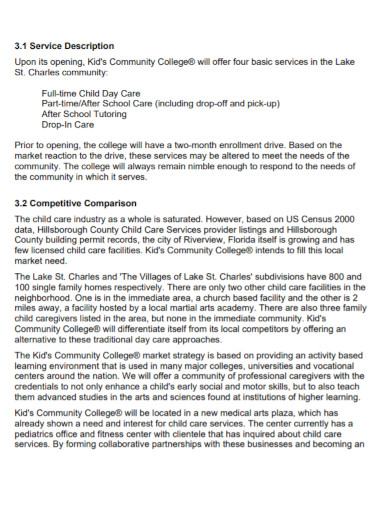
Size: 171 KB
6. Fairview Daycare Business Plan
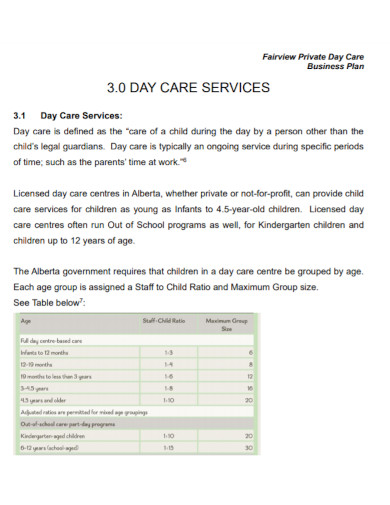
7. Printable Daycare Business Plan
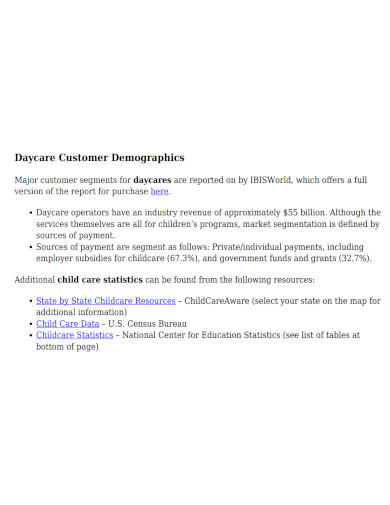
Size: 82 KB
What Is a Daycare Business Plan?
A daycare business plan is a written document that enumerates the goals of a childcare business and specifies the methods to accomplish them. It also includes the marketing strategy to promote the daycare and a framework detailing how they can set their daycare apart from similar businesses. This business plan prioritizes services that focus on teaching and securing the safety of the children.
How To Compose a Productive Daycare Business Plan
Preschool parents are hard to impress. They are very critical in scrutinizing every daycare they come across. To hook these parents, devise an impressive daycare business plan that would make them choose your daycare. Taking care of children is a significant task. To make sure you can cater to the children’s needs, be careful in creating your business plan.
1. Make a Plan Outline
Start your plan outline by including a list of your goals and the corresponding procedure you plan to follow in achieving them. Your outline would serve as your draft. That said, you can list everything that comes to mind and come back to review and omit the items that don’t contribute to the effectiveness of your plan. There are available sample outline formats and templates online.
2. Study Your Market
The people you’re offering your services to are both the children and their parents. You should focus on that fact the entire process of your plan-making. You should always ask yourself, “will it be the best for the children?”, “will it satisfy the parents?”. The best way of data-gathering is by conducting an interview and through market research .
3. Run a Competitor SWOT Analysis
Aside from your market, also research your daycare competitions. What are their strengths? What about their weaknesses, opportunities, and threats? You will find out by conducting a competitor SWOT analysis on them. The data you can gather will help you to find out what your advantage and disadvantages over them are.
4. Formulate Your Marketing Strategy
In creating your marketing strategy plan , it is advisable to appeal more to the parents because they are the ones who would decide on the final call regarding their daycare choice. Despite that, it is essential to keep your content strategy and designs child-friendly. Some marketing strategies you can try out are posting a flyer or creating an infomercial about your daycare business.
What are the parts of a business plan?
The title page, executive summary , marketing strategy plan, business description, competition analysis, operation plan, design plan, and business budget are the parts of a business plan. Each segment of this document is necessary for ensuring the accomplishment of your objectives. Tailor your business plan depending on the nature of your business.
How can I attract parents to my daycare?
Promoting your daycare on social media is a clever way of spreading awareness about your daycare. Another way is to depend on peer-to-peer (P2P) marketing. This type of marketing entails asking your existing customers to recommend your daycare to other parents they know. Parents tend to trust other parents more when they see good results.
What are the various types of business plans?
The types of business plans vary on their purpose and on the mediums used in creating them. The miniplan, the first type, is like a summary of the whole business plan. It focuses on the top priorities of the business. The second type of plan is the presentation plan, which uses PowerPoint presentations. The third one is the working plan, and the last one is the what-if plan.
Parents want the best for their children. Now, your job is to prove that you are the best, and they would naturally pick your daycare. Proving to be the top in offering childcare services is not fun and games. It requires the best daycare business plan. Win the hearts of the parents and prepare to receive several daycare application forms by the start of the enrollment period.
Text prompt
- Instructive
- Professional
Create a study plan for final exams in high school
Develop a project timeline for a middle school science fair.
Academia.edu no longer supports Internet Explorer.
To browse Academia.edu and the wider internet faster and more securely, please take a few seconds to upgrade your browser .
Enter the email address you signed up with and we'll email you a reset link.
- We're Hiring!
- Help Center

Day Care Center Business Plan

Related Papers
Vô Hình Việt
Loading Preview
Sorry, preview is currently unavailable. You can download the paper by clicking the button above.
- We're Hiring!
- Help Center
- Find new research papers in:
- Health Sciences
- Earth Sciences
- Cognitive Science
- Mathematics
- Computer Science
- Academia ©2024
Watch CBS News
Project 2025 would overhaul the U.S. tax system. Here's how it could impact you.
By Aimee Picchi
Edited By Anne Marie Lee
Updated on: July 12, 2024 / 1:42 PM EDT / CBS News
Project 2025, a 900-page blueprint for the next Republican president, is gaining attention for its proposals to overhaul the federal government. Among those changes: a major restructuring of the U.S. tax code.
President Biden and Democrats have been citing Project 2025 in recent weeks as they seek to highlight what could be in store if former President Donald Trump wins at the polls in November and retakes the White House in January. Many of the blueprint's proposals touch on economic matters that could impact millions of Americans, as well as social issues such as abortion and diversity, equity and inclusion, or DEI, topics.
Project 2025 , overseen by the conservative Heritage Foundation, is spearheaded by two ex-Trump administration officials: project director Paul Dans, who was chief of staff at the Office of Personnel Management, and Spencer Chretien, former special assistant to Trump who is now the project's associate director.
Trump: "I know nothing about Project 2025"
For his part, Trump has distanced himself from the blueprint, writing on Truth Social early Thursday that he isn't familiar with the plan. His campaign has proposed its own goals through " Agenda 47 ," which tends to focus on social and political issues such as homelessness and immigration rather than taxes.
"I know nothing about Project 2025. I have not seen it, have no idea who is in charge of it, and, unlike our very well received Republican Platform, had nothing to do with it," Trump wrote Thursday.
His pushback comes after Heritage Foundation President Kevin Roberts opined in a podcast interview that the U.S. is "in the process of the second American Revolution, which will remain bloodless if the left allows it to be."
According to Project 2025's website, its goal is to have "a governing agenda and the right people in place, ready to carry this agenda out on day one of the next conservative administration."
A shift to two brackets
The tax proposals of Project 2025, if enacted, would likely affect every adult in the U.S. by tossing out the nation's long-standing system of multiple tax brackets, which is designed to help lower-income Americans pay a smaller share of their income in federal taxes compared with middle- or high-income workers.
Currently, there are seven tax brackets — 10%, 12%, 22%, 24%, 32%, 35% and 37% — with each based on income thresholds. For instance, a married couple pays 10% in federal income tax on their first $23,200 of income, and then 12% on earnings from $23,201 to $94,300, and so on. Married couples need to earn over $487,450 this year to hit the top tax rate of 37%.
Project 2025 argues that the current tax system is too complicated and expensive for taxpayers to navigate. To remedy those problems, it proposes just two tax rates: a 15% flat tax for people earning up to about $168,000, and a 30% income tax for people earning above that, according to the document . It also proposes eliminating "most deductions, credits and exclusions," although the blueprint doesn't specify which ones would go and which would stay.
"The federal income tax system is progressive, and people who make more money pay a higher marginal tax rate than people who make less money," Brendan Duke, senior director for economic policy at the left-leaning Center for American Progress, told CBS MoneyWatch. "Conservatives look at that, and they feel that that's unfair to the wealthy to ask them to pay a greater share of their income in taxes than lower income families."
The Project 2025 proposal "is a dramatic reform of how we fund our government, where we ask the wealthy to pitch in more than lower income families," he said. "This shifts taxes from the wealthy to the middle class, full stop."
Project 2025 didn't immediately respond to a request for comment.
In a statement, the Heritage Foundation said it will ultimately be up to the next conservative president do decide which recommendations to implement, adding "As we've been saying for more than two years now, Project 2025 does not speak for any candidate or campaign."
Project 2025's tax rates
Millions of low- and middle-class households would likely face significantly higher taxes under the Project 2025's proposals.
He estimated that a middle-class family with two children and an annual income of $100,000 would pay $2,600 in additional federal income tax if they faced a 15% flat tax on their income due to the loss of the 10% and 12% tax brackets. If the Child Tax Credit were also eliminated, they would pay an additional $6,600 compared with today's tax system, Duke said.
By comparison, a married couple with two children and earnings of $5 million a year would enjoy a $325,000 tax cut, he estimated.
"That 15% bracket is a very big deal in terms of raising taxes on middle-class families," Duke said.
Millions of U.S. households earning less than $168,000 would likely face higher taxes with a 15% rate. Currently, the bottom half of American taxpayers, who earn less than $46,000 a year, pay an effective tax rate of 3.3% — which reflects their income taxes after deductions, tax credits and other benefits.
Among other tax and economic changes proposed by Project 2025:
- Cutting the corporate tax rate to 18% from its current 21%, which was enacted in 2017's Tax Cuts and Jobs Act. Prior to the TCJA, the corporate tax rate stood at 35%.
- Reducing the capital gains tax to 15%. Currently, high-income earners pay a tax of 20% on their capital gains.
- Eliminating credits for green energy projects created by the Inflation Reduction Act.
- Considering the introduction of a U.S. consumption tax, such as a national sales tax.
- Eliminating the Federal Reserve's mandate to maintain full employment in the labor market.
To be sure, overhauling the tax system would require lawmakers to approve changes to the tax code, which could be difficult if either the House or Senate is controlled by the opposing party. For instance, Trump was able to get his Tax Cuts and Jobs Act passed by a Republican-led Congress, even though no Democrats voted in support of the measure.
What does Trump say about taxes?
Trump hasn't yet proposed any concrete tax plans, but analysts expect that he would seek to extend the tax cuts enacted through the TCJA if he is reelected. Currently, many of the provisions of the TCJA, including lower tax brackets, are set to expire at the end of 2025.
One likely scenario if Trump is reelected is that Republican lawmakers would extend the TJCA's tax cuts, while seeking to fund the reduction in tax revenue by repealing some of the clean energy and climate-related provisions in the Biden administration's Inflation Reduction Act, according to an April report from Oxford Economics. Lawmakers could also seek to cut spending on social benefits to offset the tax cuts, the research firm added.
Trump has suggested a proposal to create a 10% tariff for all imports and a 60% tariff for Chinese imports that could raise enough money to eliminate the federal income tax.
Tax experts also say the math doesn't work out because money raised from new tariffs would fall far short of replacing the more than $2 trillion in individual income taxes collected by the IRS each year. Consumers are also likely to pay more in higher costs for imported consumer goods and services with tariffs tacked onto them, experts note.
"A tariff is a consumption tax, and there is a throughline between [Project 2025's] tax reform and what Trump has talked about, getting rid of taxes in favor of a consumption tax," Duke noted.
- Donald Trump
Aimee Picchi is the associate managing editor for CBS MoneyWatch, where she covers business and personal finance. She previously worked at Bloomberg News and has written for national news outlets including USA Today and Consumer Reports.
More from CBS News

Highlights from the 2024 Republican National Convention

At Trump's GOP Convention, there's little to be heard on health care

Investors are putting their money on the "Trump trade."

An unconventional week in presidential politics

IMAGES
VIDEO
COMMENTS
The real version of Growthink's Ultimate Daycare Business Plan Template is much more than a fill-in-the-blanks template. The template professionally guides you step-by-step so you can quickly, easily, and expertly complete your business plan. Perhaps most importantly, it includes complete financial projections.
Daycare Business Plan PDF Example. Adam. February 28, 2024. Business Plan. Creating a comprehensive business plan is crucial for launching and running a successful daycare. This plan serves as your roadmap, detailing your vision, operational strategies, and financial plan. It helps establish your daycare's identity, navigate the competitive ...
The US child day-care industry is one of the largest in the world, owing mainly to the prevalence of a culture where both parents choose to pursue a career. Cumulatively, the industry is estimated to value as much as 235 billion U.S. dollars during 2019-2023. It ... Daycare Business Plan Template ...
Daycare Business Plan Template. Download our template and create a business plan for your daycare! When you are ready to start a daycare business, you need an effective plan outlining how to get there. High-quality child care is in high demand, but you must be prepared for the challenges of starting a new business.
Updated July 31, 2023. A daycare business plan is a written document outlining the mission, objectives, and strategy of a child care business. The plan can be used to guide internal operational plans as well as inform prospective investors or lenders. Typically, a daycare business plan should include an executive summary, company and management description, market analysis, and financial ...
This daycare business plan example shows you how to include this vital information: "The daycare will be located at 123 Main Street in a commercial space currently leased by the owner. The lease agreement is for three years with an option to renew for an additional three years.
Thus, including a web strategy in your business plan is necessary. Always remember, as a daycare service coming off as a trustworthy and reliable institution is crucial for your business to work. 5. Management and Organizational Structure. Having a well-structured management system is especially crucial for a daycare service.
Get the most out of your business plan example. Follow these tips to quickly develop a working business plan from this sample. 1. Don't worry about finding an exact match. We have over 550 sample business plan templates. So, make sure the plan is a close match, but don't get hung up on the details. Your business is unique and will differ from ...
It all starts with creating a good daycare business plan. With the right plan in place, opening a daycare has never been easier! Our comprehensive guide will walk you through creating a business plan. At the end, be sure to download our free template and hit the ground running! Video - Daycare Business Plan.
Child Care Business Plan Template. Over the past 20+ years, we have helped over 5,000 entrepreneurs and business owners create business plans to start and grow their child care centers. On this page, we will first give you some background information with regards to the importance of business planning. We will then go through a child care ...
Smart lead and customer CRM system. Organized leads scored and prioritized with easy-to-use dashboards and sort functionality. Graphic dashboards and iconography provide at-a-glance lead data and lead engagement status. Best practices and sales tool tips embedded in technology to support lead conversion.
A business plan is a written document that describes your child care center's goals, why you think those goals are attainable, and how you plan to achieve them. Preparing a business plan forces you to think about all the things you need to plan and implement in order to start your business, expand your business, or achieve your program and ...
Developing the Child Care Center Business Plan is a process which includes: • Outlining the general concept of your center. • Conducting research. • Refining your ideas based on your research. • Developing specific components of the Plan. The Child Care Center Business Plan that you develop through this process:
Future Services. Kidzvilla Community College offers upscale child care services and an advanced collegiate based curriculum designed for kids ages 4 months to 5 years and 1st through 5th grades. Normal operating hours will be 6:45 am to 6:30 pm, Monday through Friday - with the observance of all major legal holidays.
2. Assess the needs of your business. This is roughly similar to some things in the first step. In this step, you can begin by looking at the current trends that are in the child care industry. After that, follow through by beginning to narrow down the choices based on the choices that suit your area the most.
For those in search of a customized solution, we provide a downloadable 'Daycare Business Plan PDF'. This document is indispensable for entrepreneurs dedicated to crafting a persuasive and effective strategy for launching or enhancing their daycare business. The 'AI Business Plan Generator' serves as a detailed guide, offering profound insights ...
1. Description of Operations. The operations section of the business plan describes the day to day functions of your child care center. It will include your key operational features including number and age-mix of the children cared for at the child care center, hours, food service, etc.
Size: 248 kB. Download Now. Luckily, there are sample daycare centers that offer enriching activities catering to a child's need. If you want to establish your own daycare, you can download a sample business plan Template on this page and start planning for those terrific childcare services.
Taking care of children is a significant task. To make sure you can cater to the children's needs, be careful in creating your business plan. 1. Make a Plan Outline. Start your plan outline by including a list of your goals and the corresponding procedure you plan to follow in achieving them. Your outline would serve as your draft.
Page 5 Safe Kids Child Care 4.4 Service Business Analysis The child care business is lucrative, as mentioned before. As a result, there are many centers that provide quality care for children in the same area as Safe Kids. The child care industry is split between large, commercially-run centers and smaller, locally-owned centers.
How Project 2025 would impact the U.S. tax code 04:18. Project 2025, a 900-page blueprint for the next Republican president, is gaining attention for its proposals to overhaul the federal government.